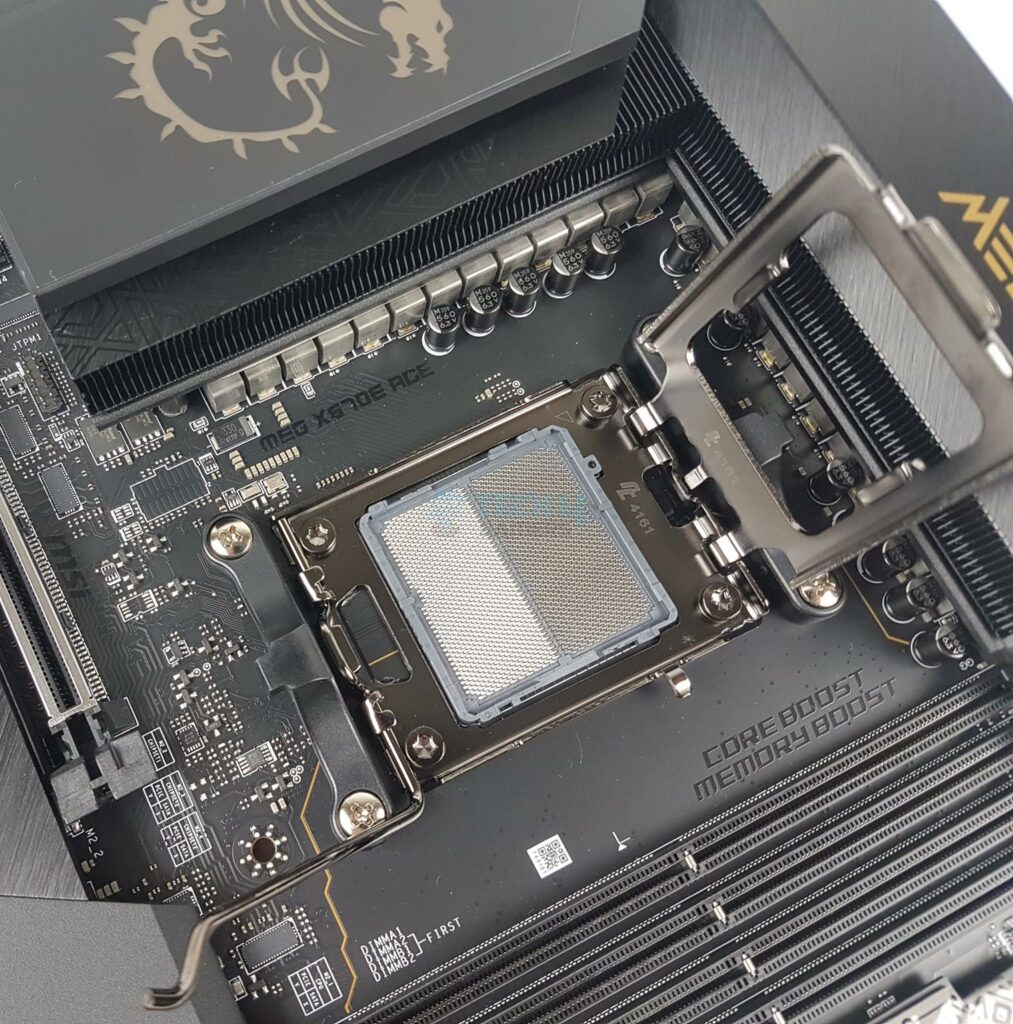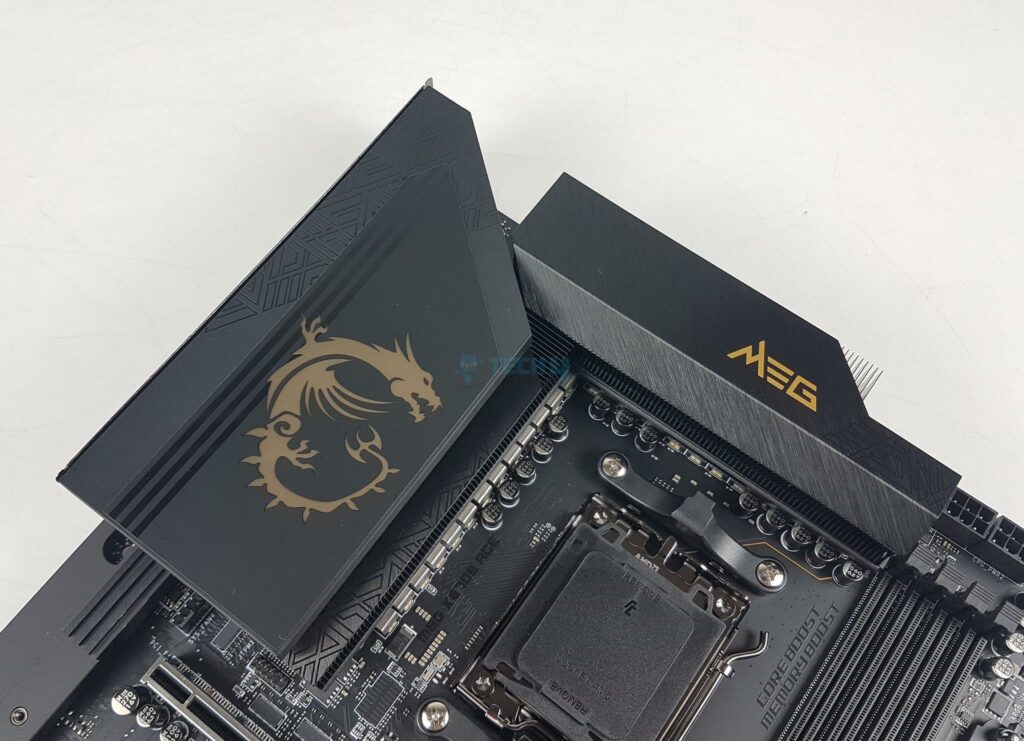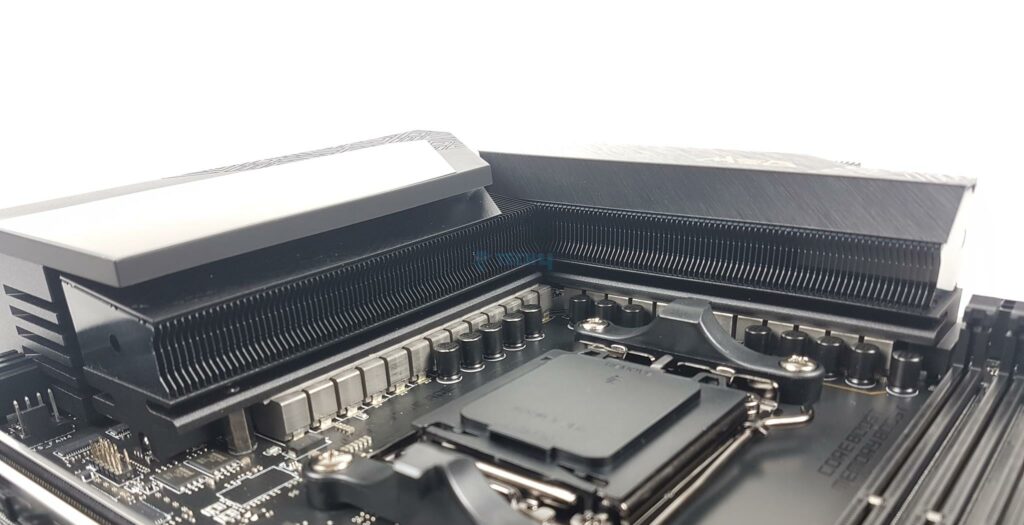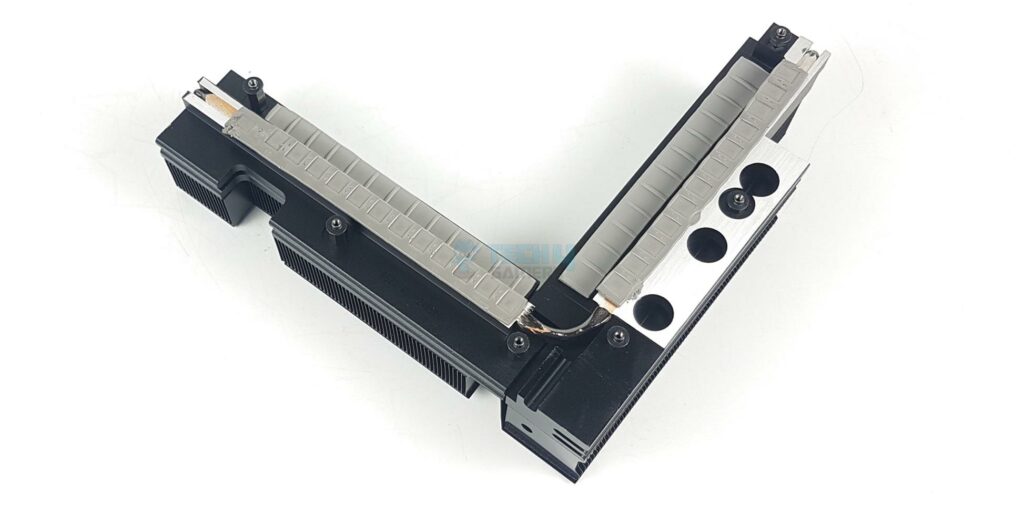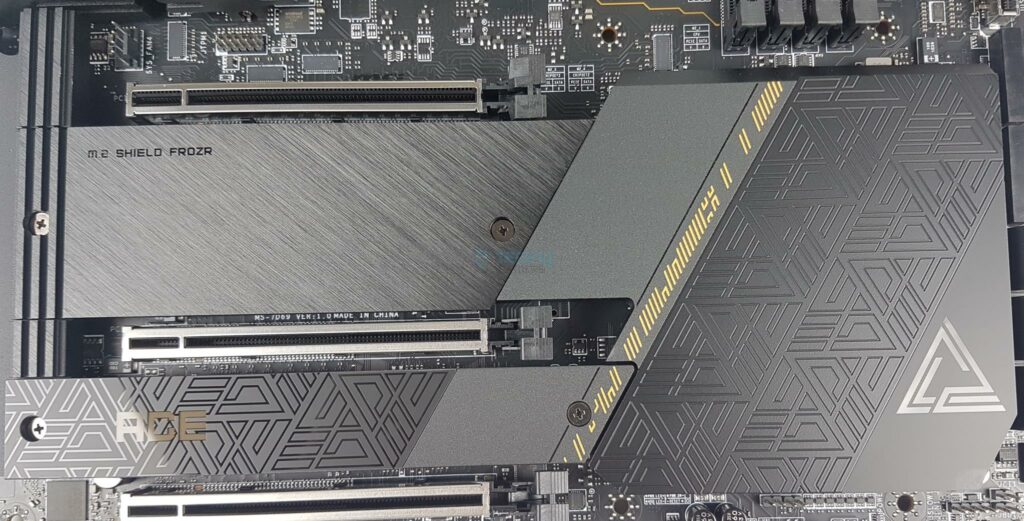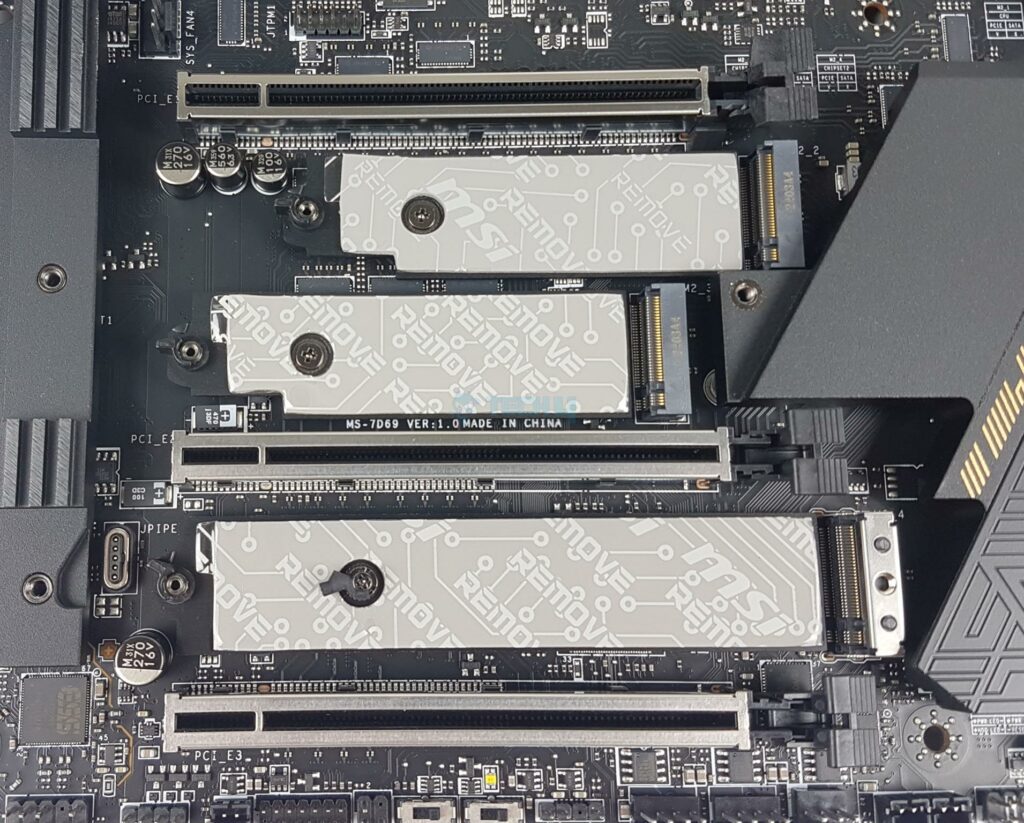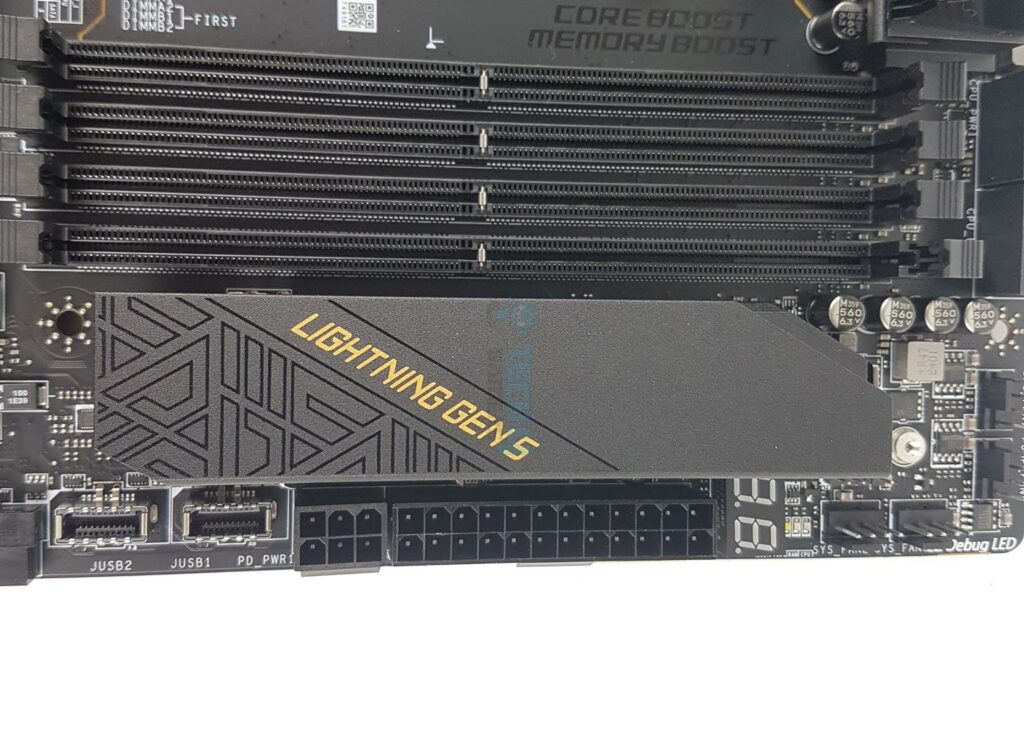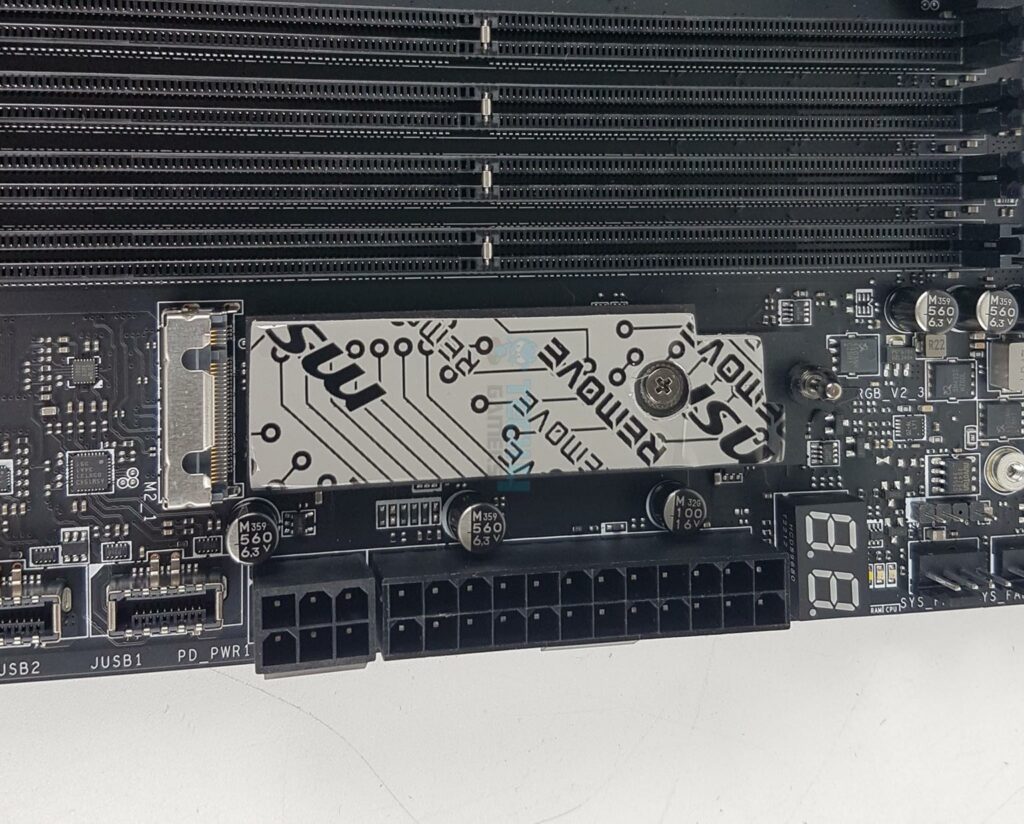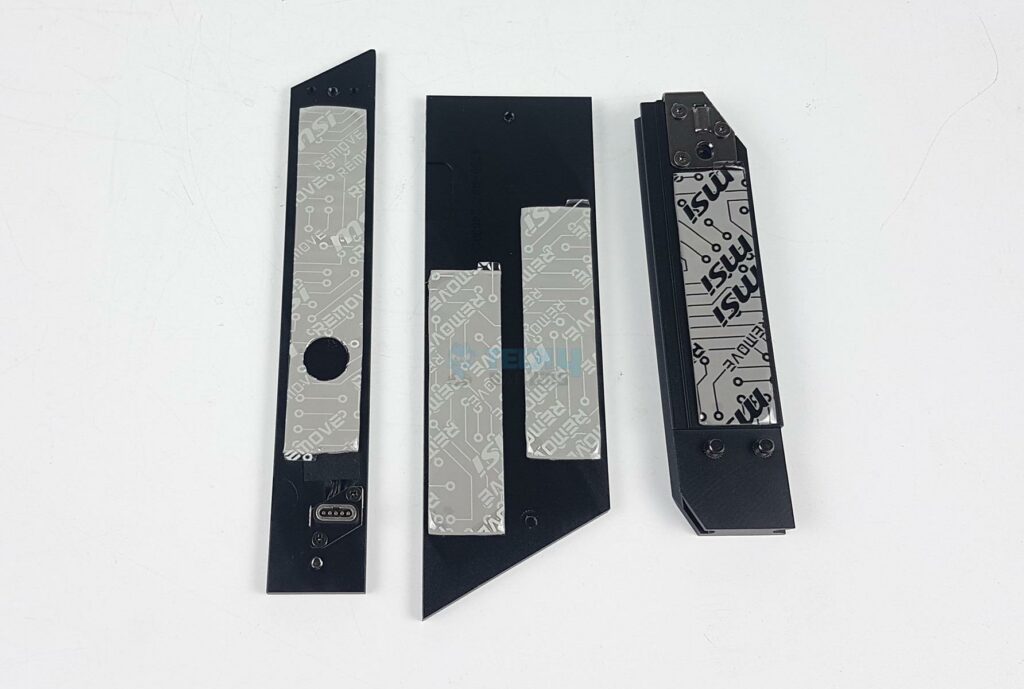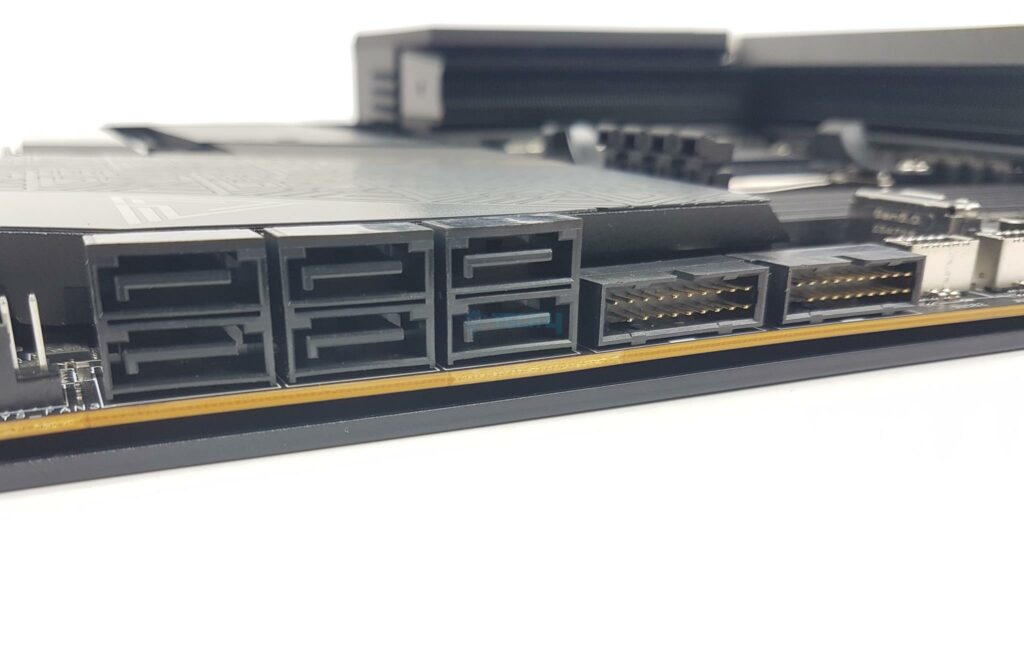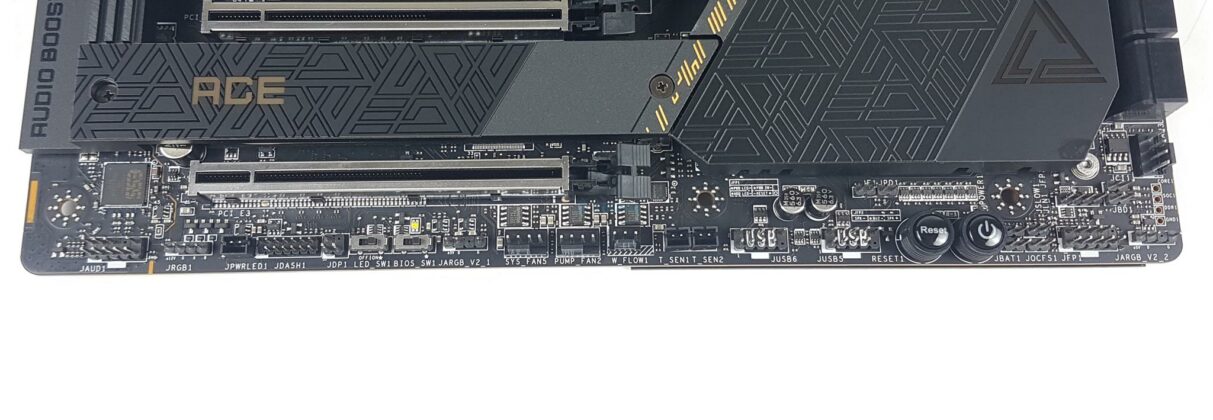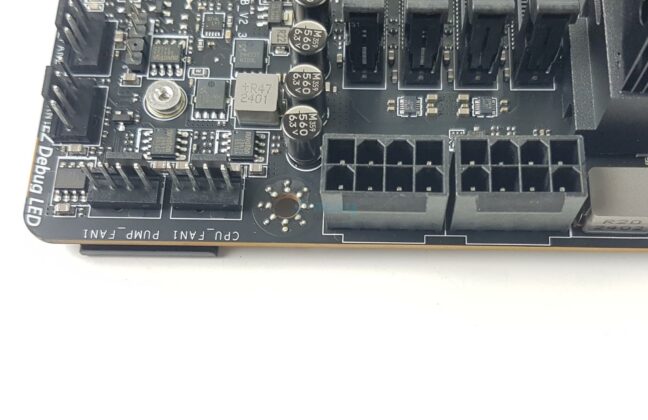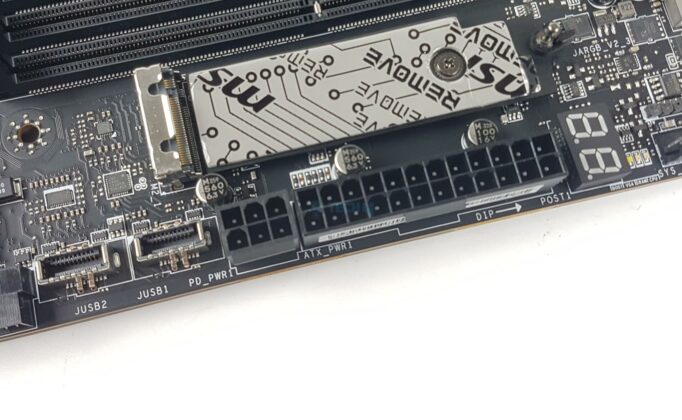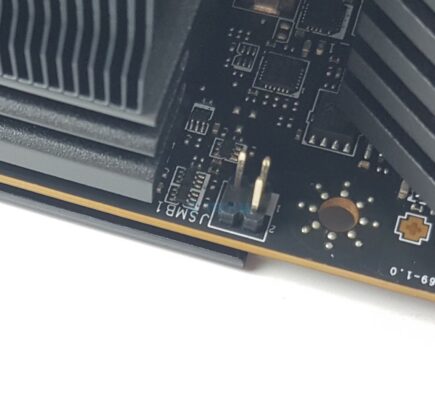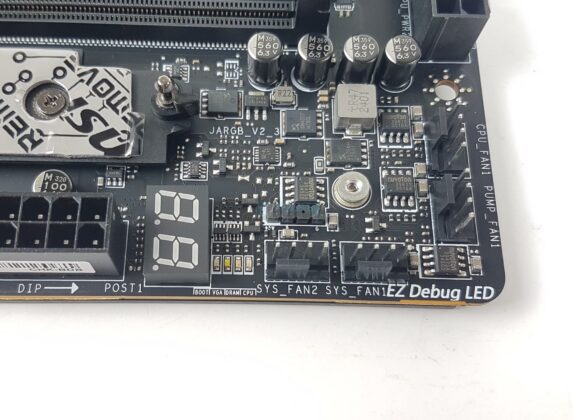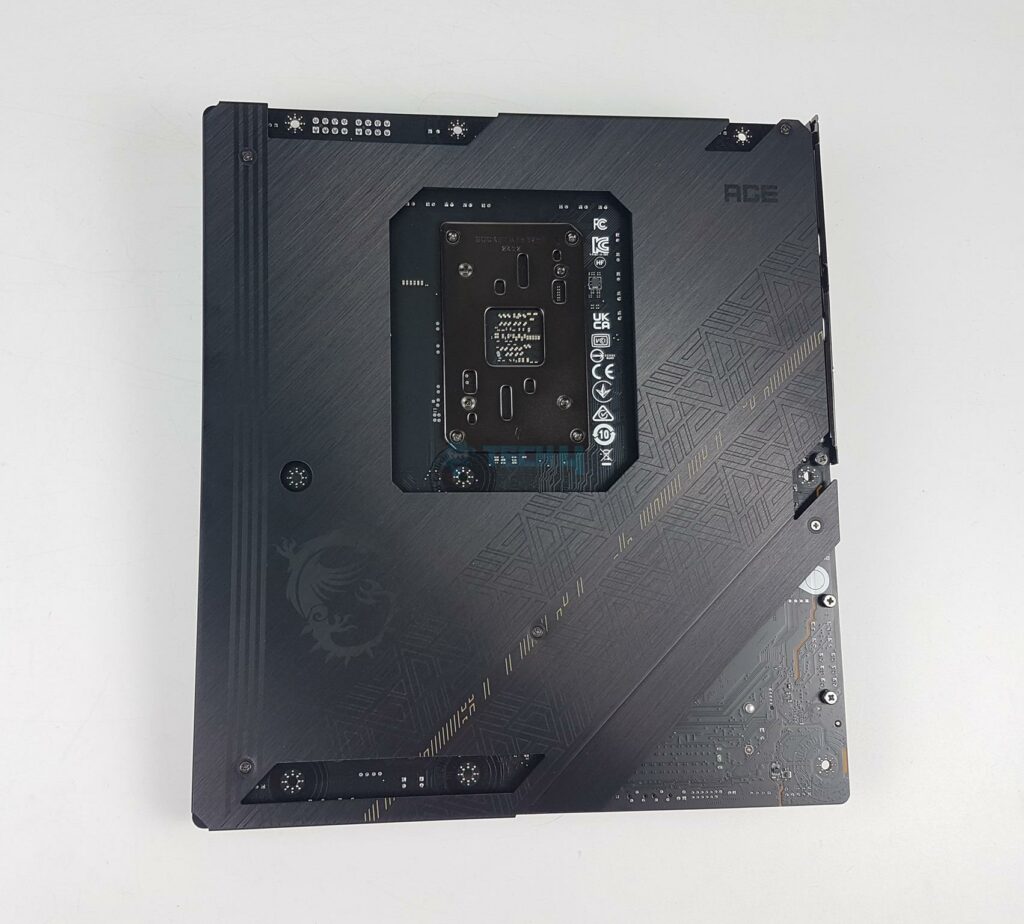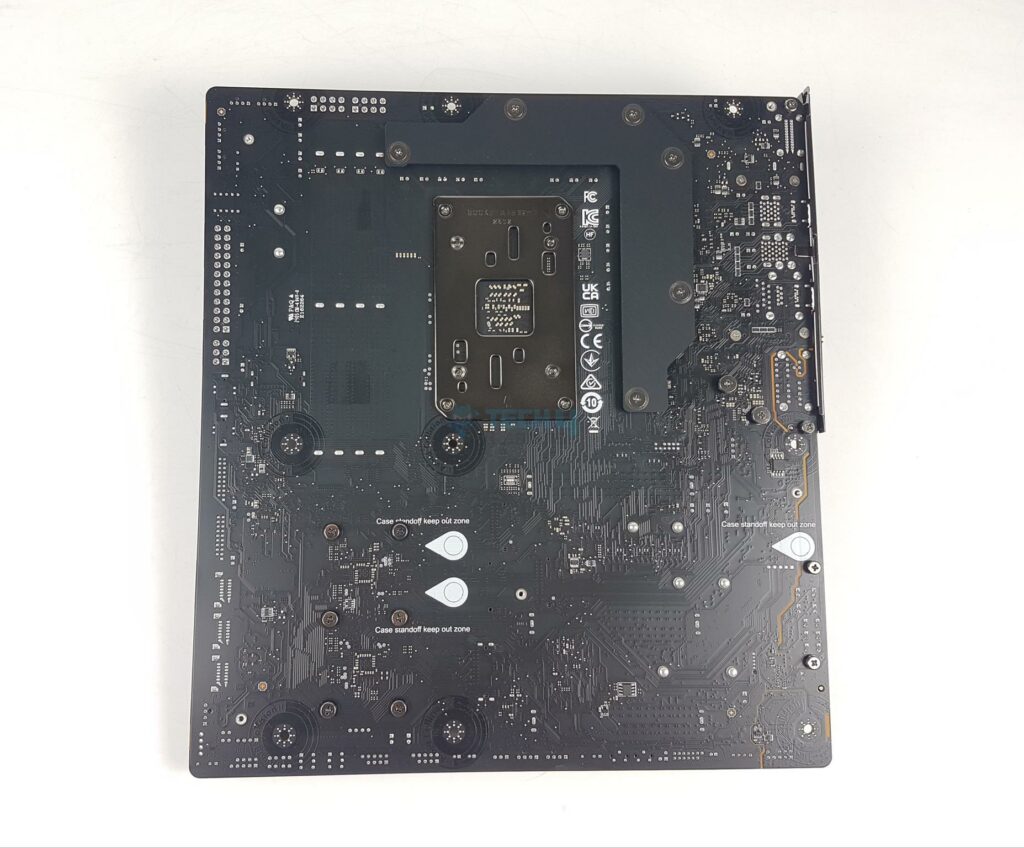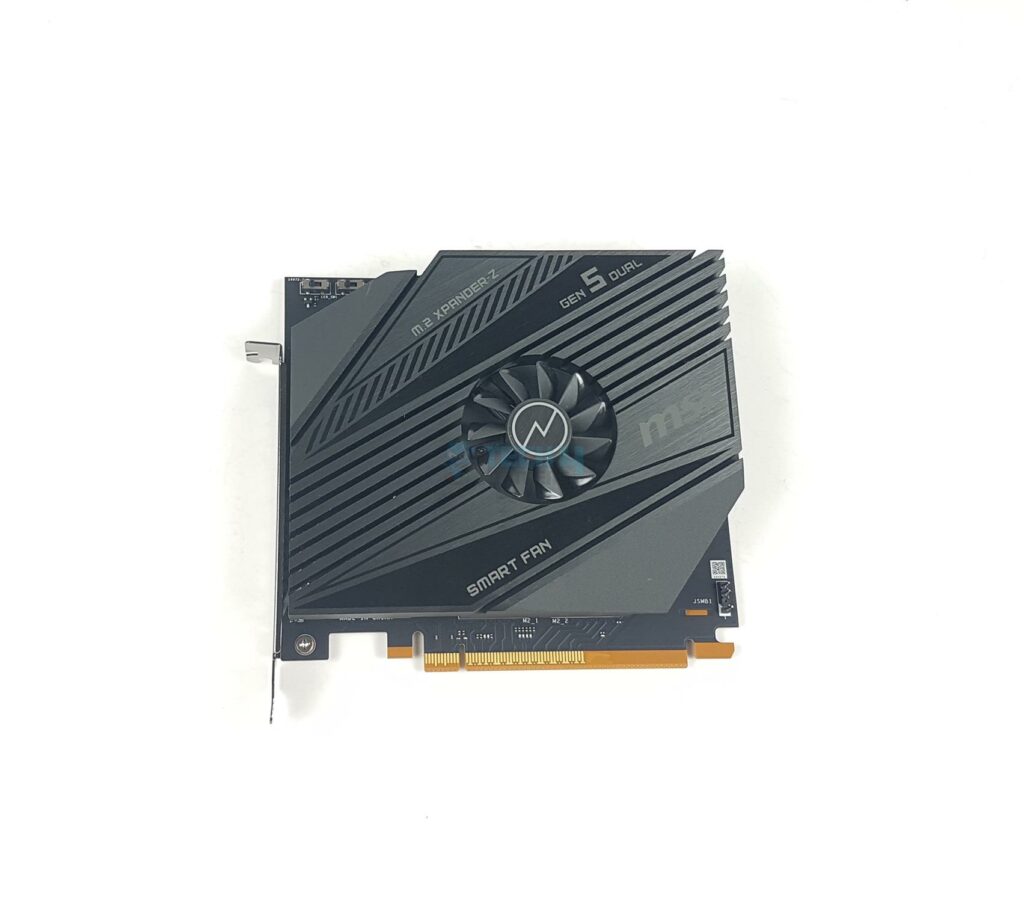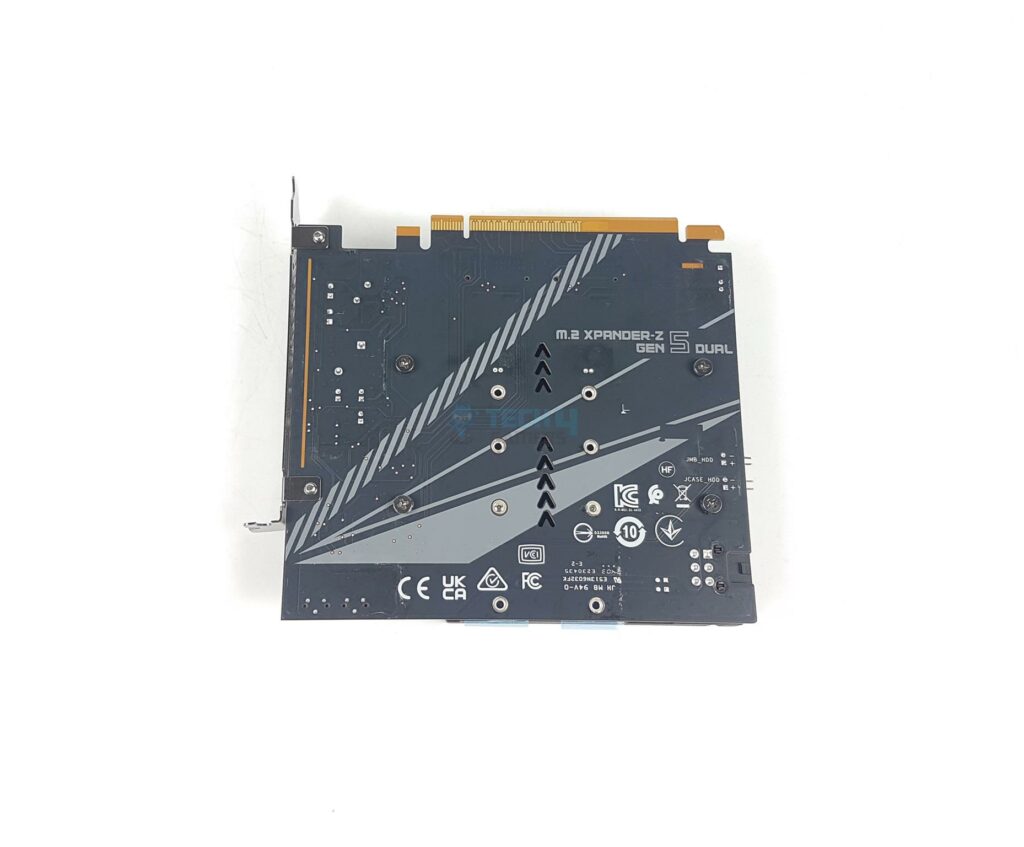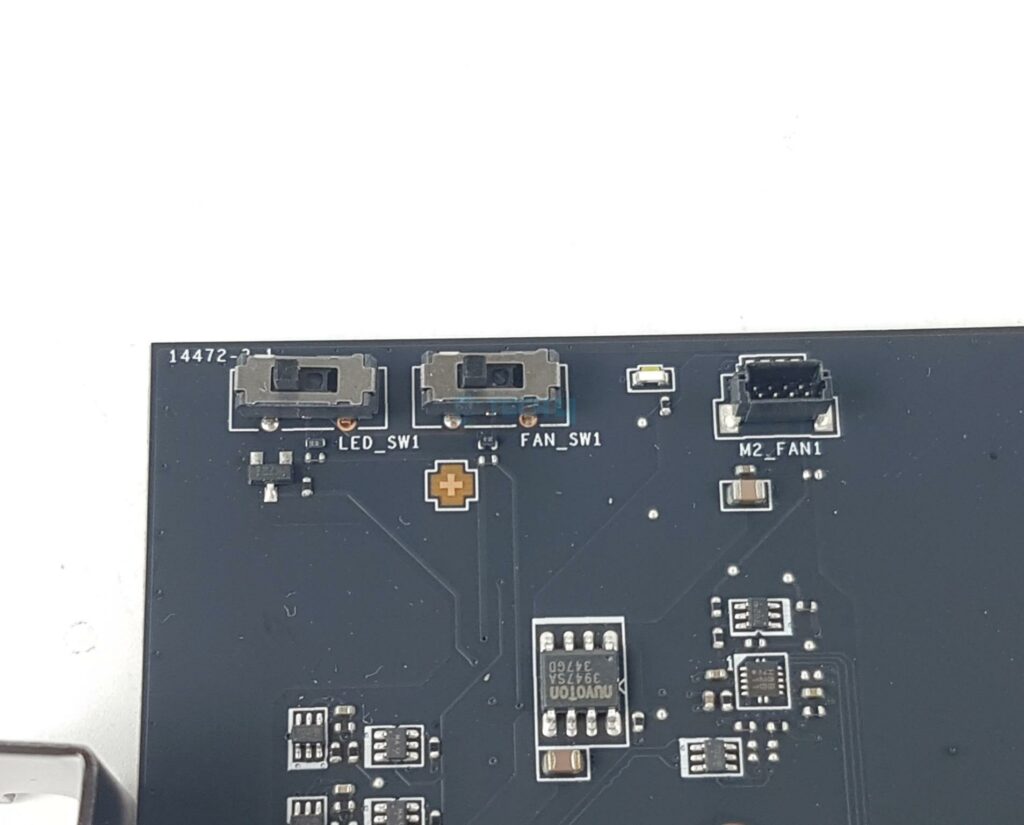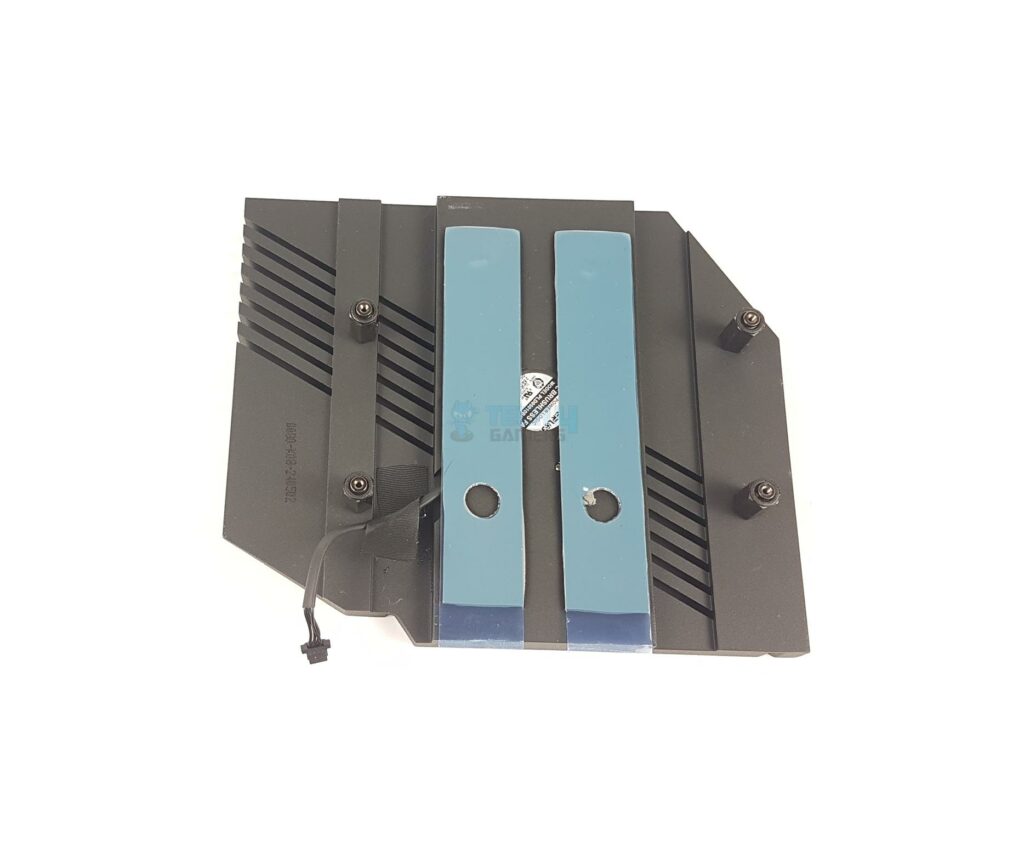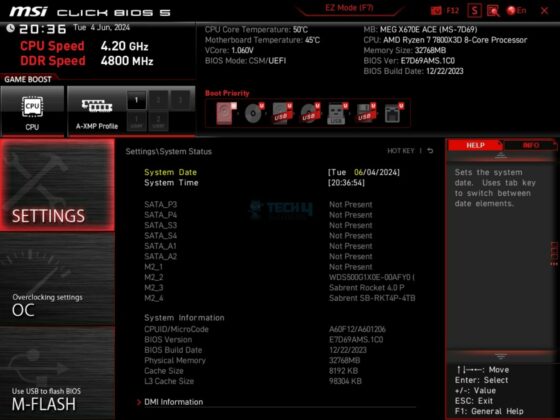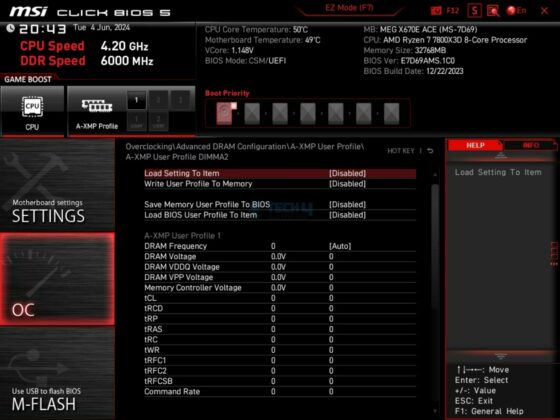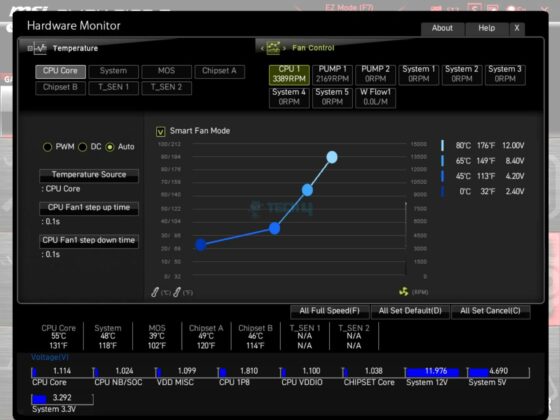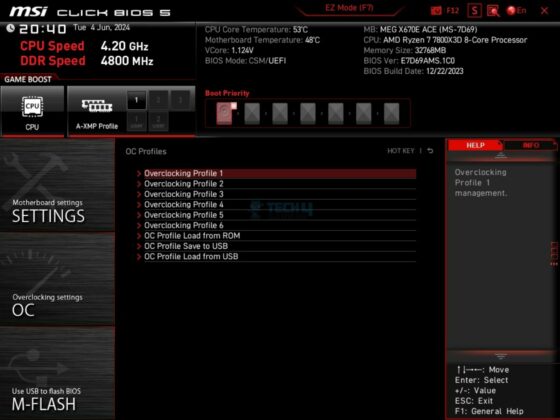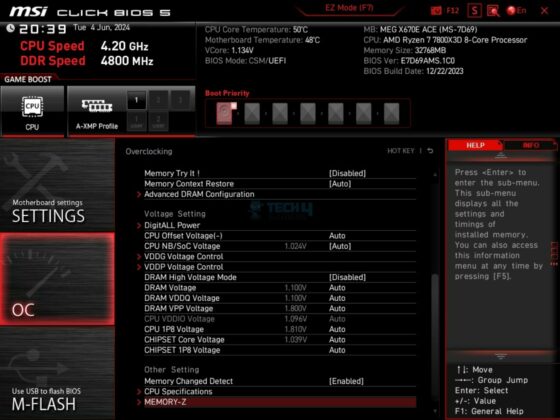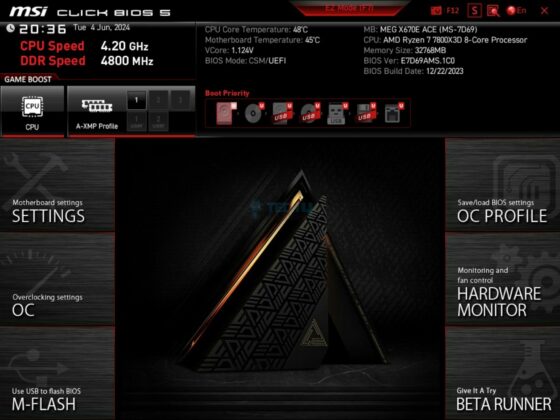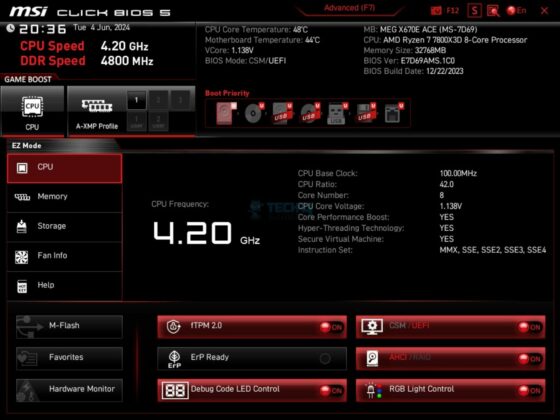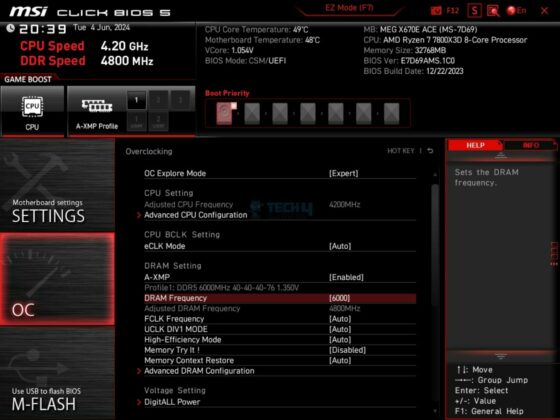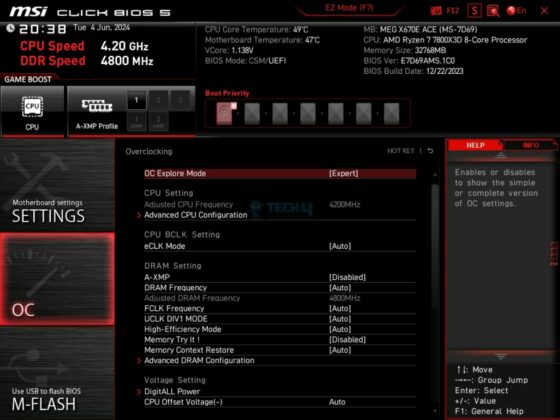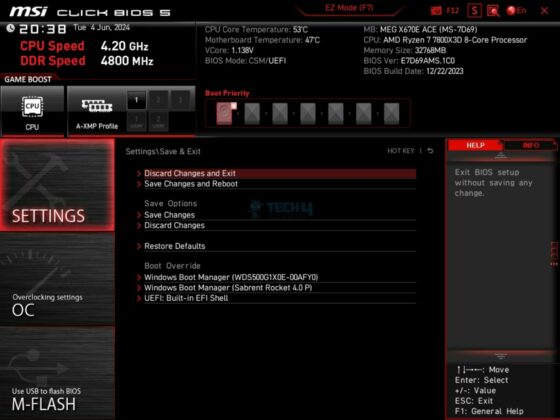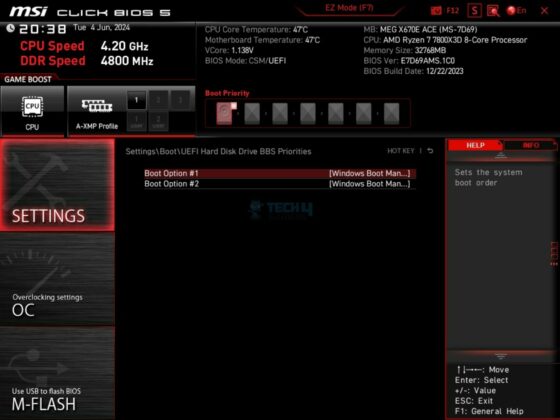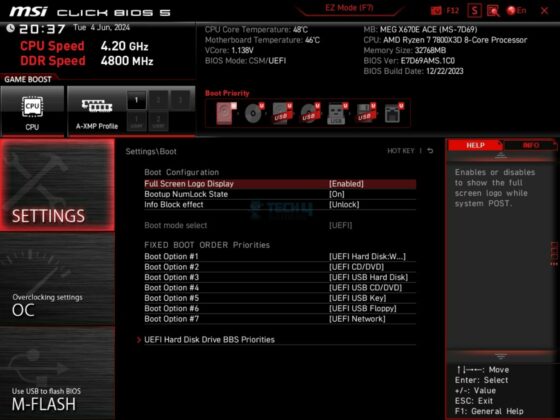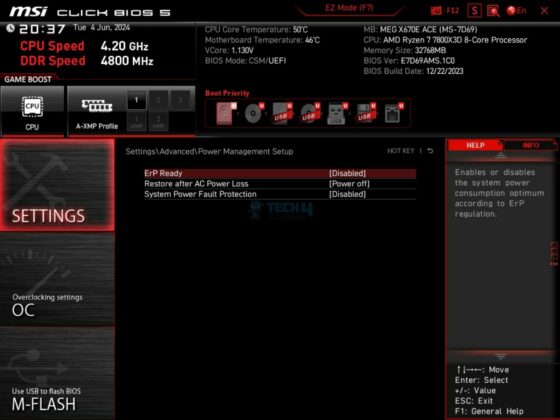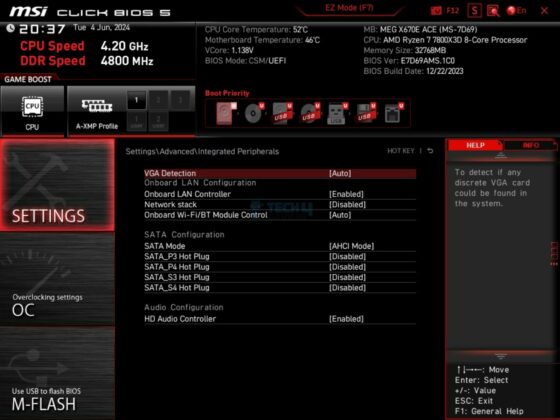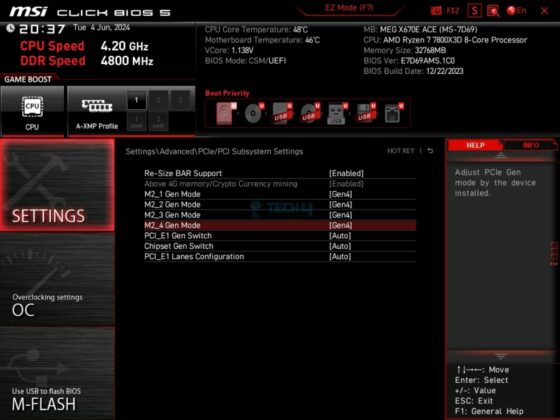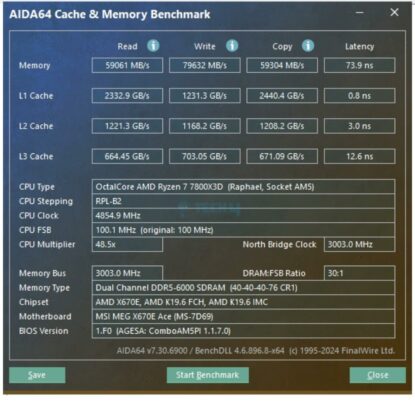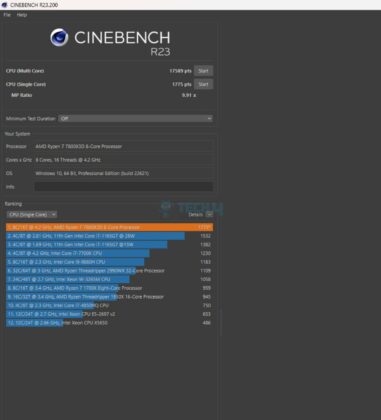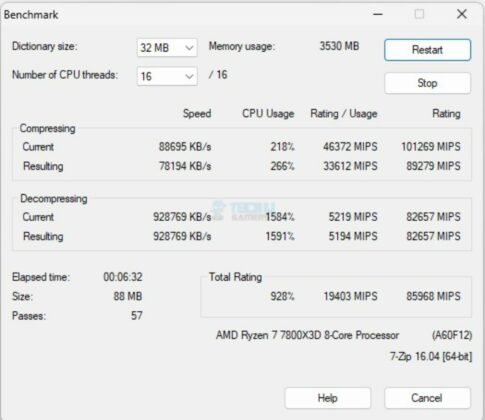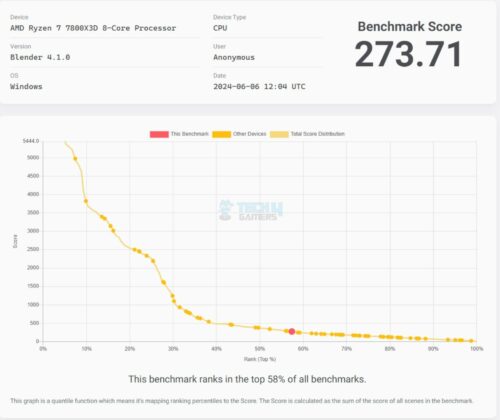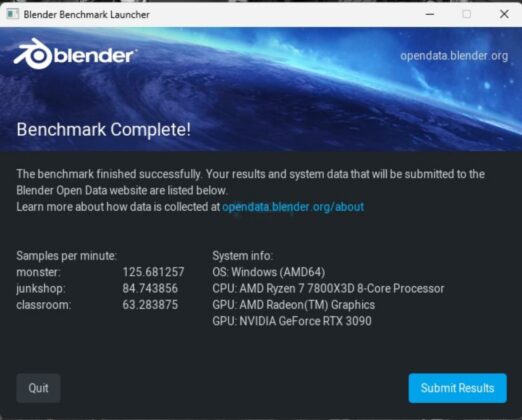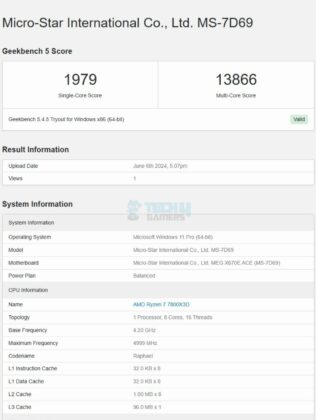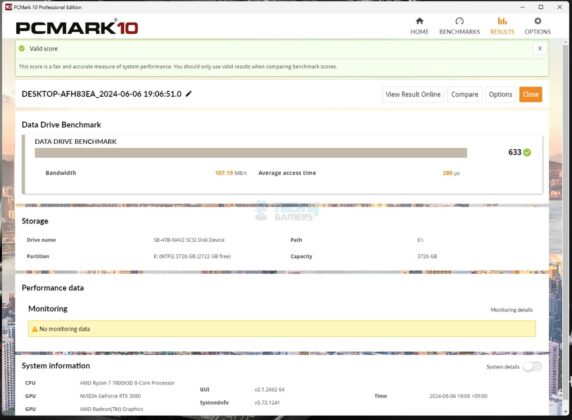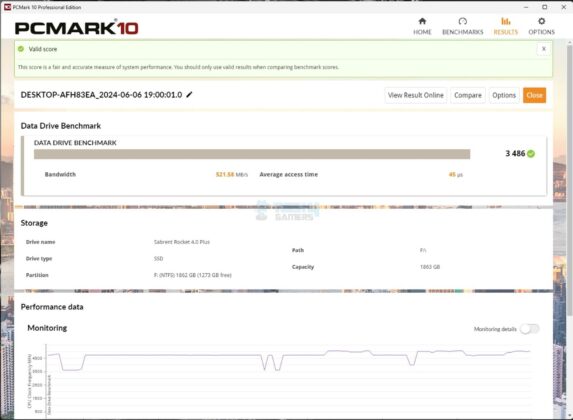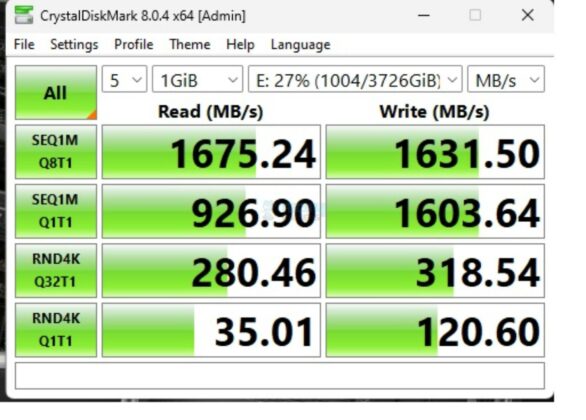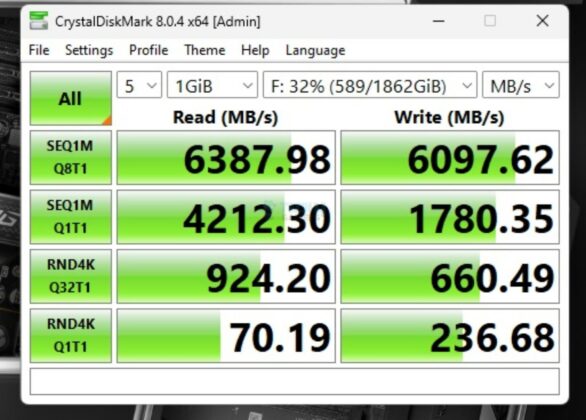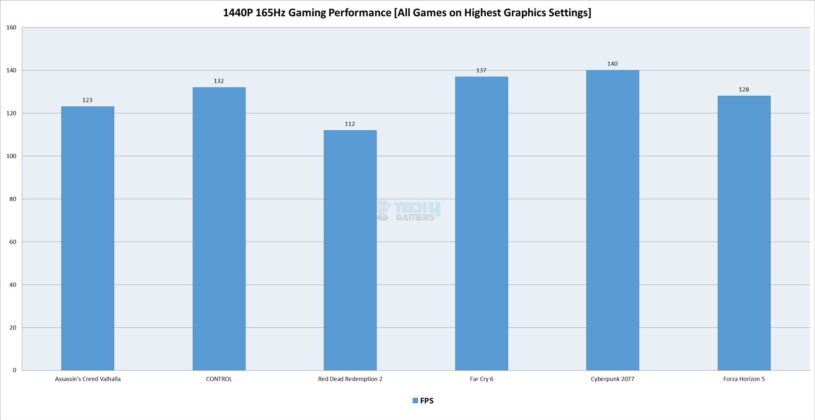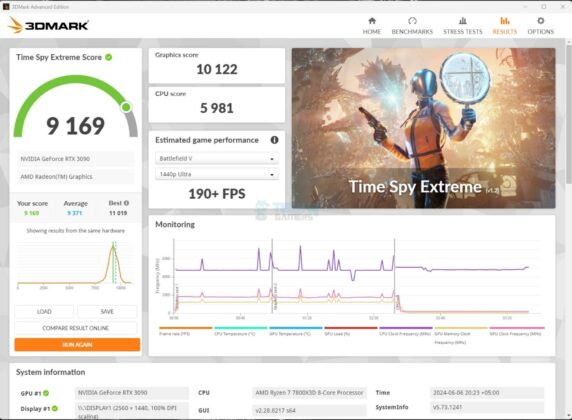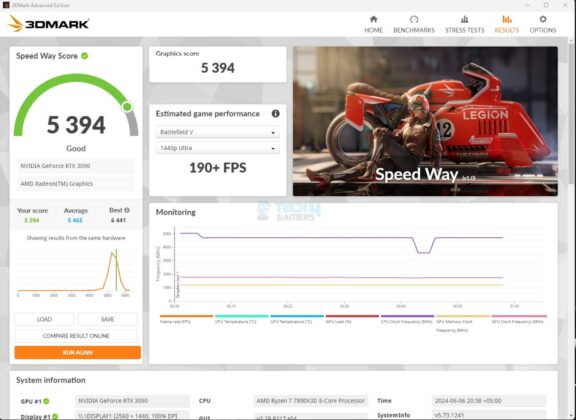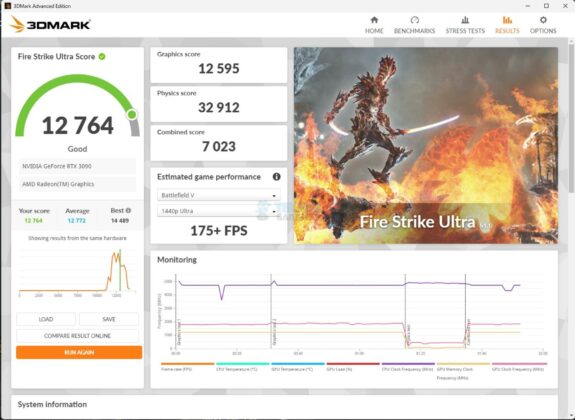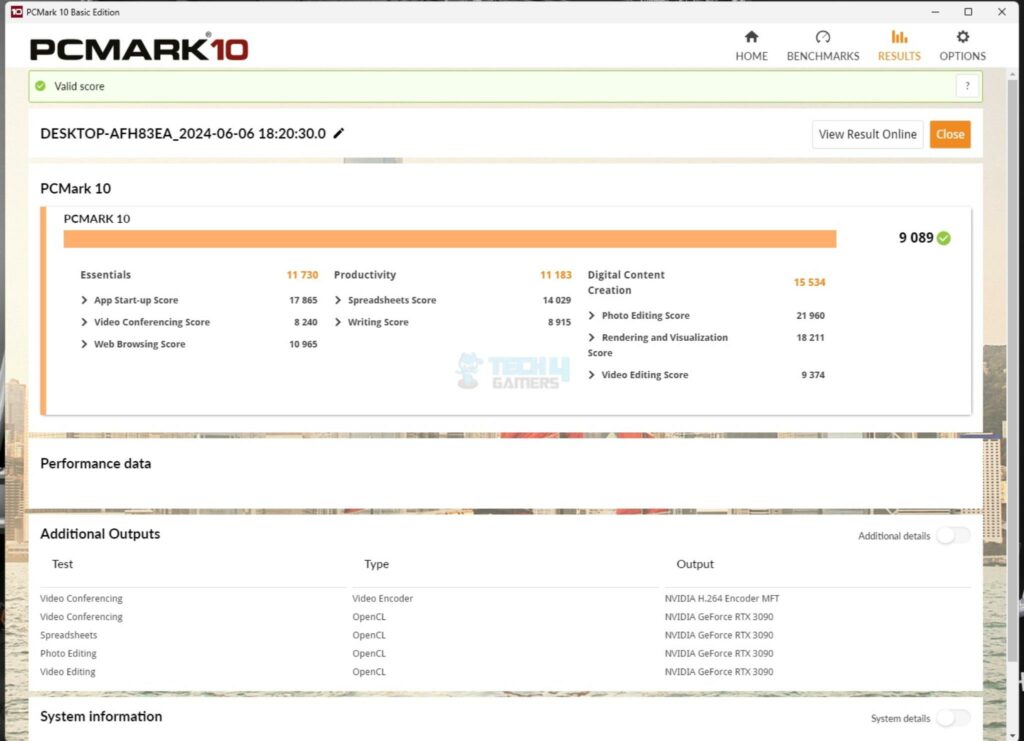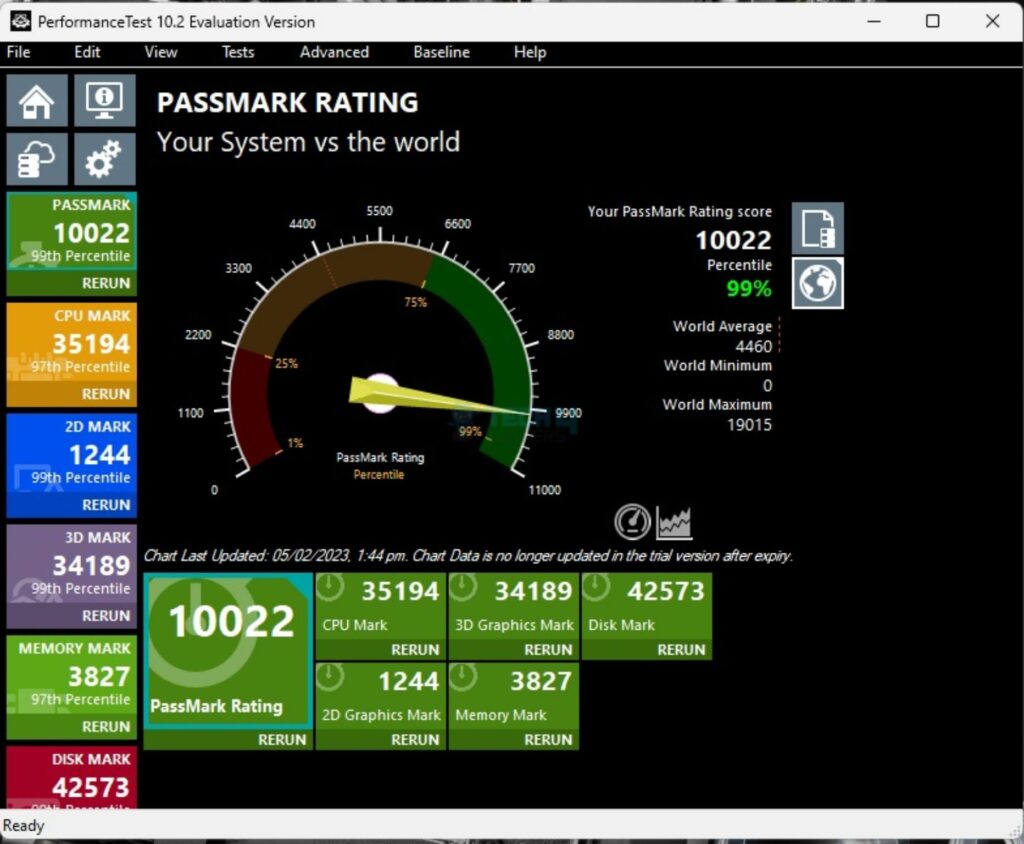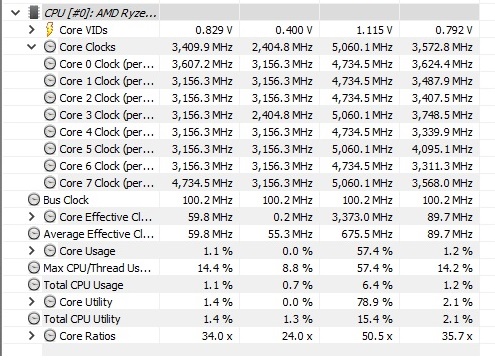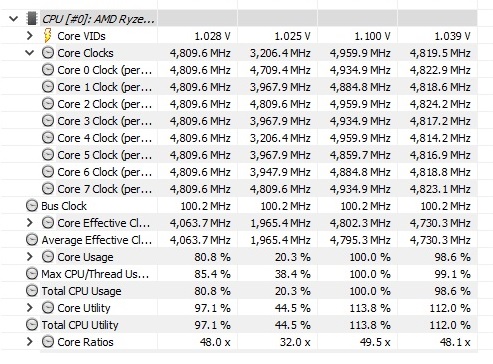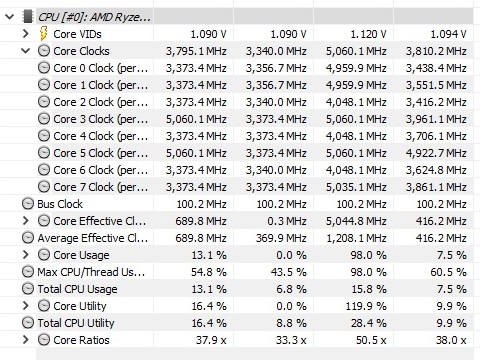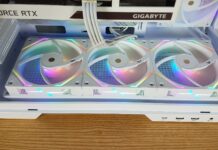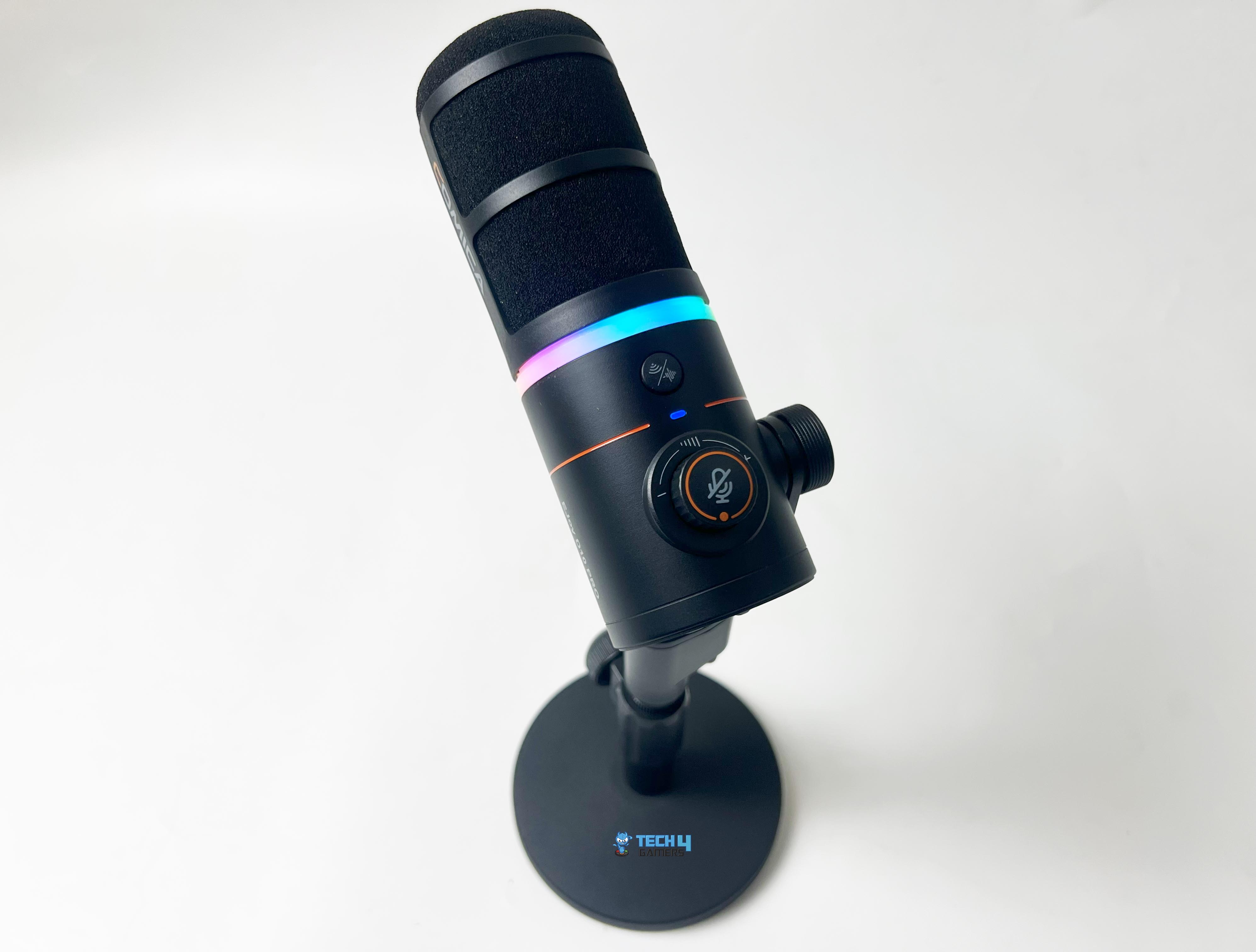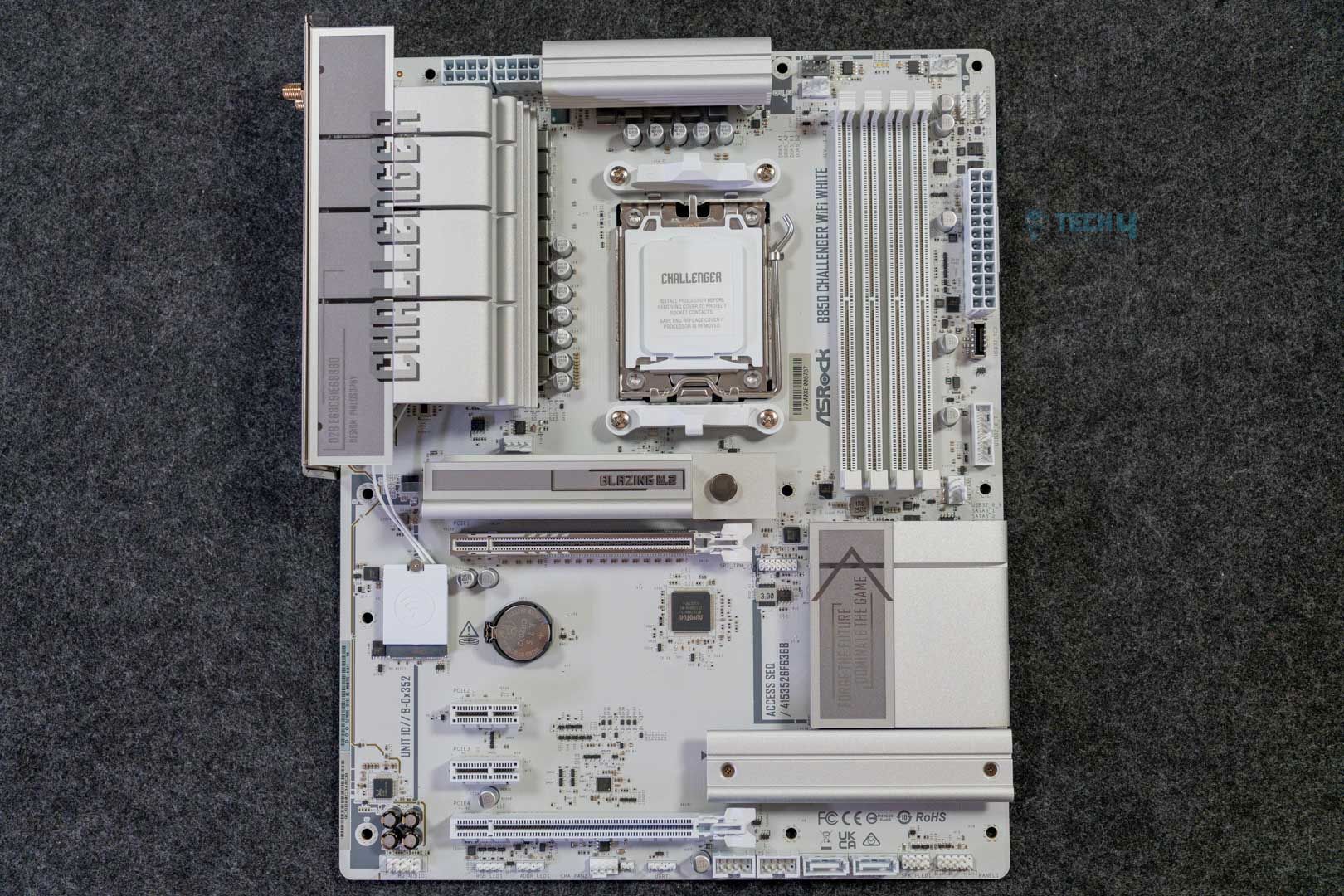Perfect For Ryzen 9000!
Review Summary
The MSI MEG X670E ACE is a flagship E-ATX motherboard designed for the AMD AM5 platform, featuring a sleek black and gold aesthetic. It supports AMD Ryzen 9000/8000/7000 series processors, DDR5 memory up to 8000+MHz (OC), and a robust 22+2+1 power phase design. The board includes six M.2 ports, an exclusive M.2 XPANDER-Z Gen5 Dual PCIe card, advanced VRM cooling, and extensive USB connectivity with 21 ports, including USB 3.2 Gen 2×2 with 60W PD. It also offers a 10G Super LAN, Wi-Fi 6E, and high-end audio with RealTek ALC4082 and ESS DAC. The MSI MEG X670E ACE stands out for its performance, comprehensive features, and premium build quality, making it a top choice for gamers and professionals.
Hours Tested: 14
Overall
-
Design - 9.5/10
9.5/10
-
Features - 9.5/10
9.5/10
-
Performance - 9/10
9/10
-
Value - 8.5/10
8.5/10
Pros
- Beefy 22+2+1 Power Phases With Excellent VRM Cooling
- V-Check read points for VCore and SoC
- 1x Gen5 M.2 Port & 3x PCIe Gen5 Steel Reinforced Slots (x16/x8/x4)
- 1x M.2 XPANDER-Z Gen5 DUAL Expansion Card
- 3x USB 3.2 Gen2x2 20Gbps Type-C Ports
- 60W PD from Type-E USB 3.2 Gen2x2 Port
- Clear CMOS & Flash BIOS Button
- Debug LED with Dual BIOS
- Backplate
Cons
- Price
I am taking a look at the flagship motherboard from the MSI MEG series driving the AMD AM5 platform. Say hi to MEG X670E ACE. This is an E-ATX form factor design with beautiful aesthetics using black and gold embellishments and featuring a PCIe card for Gen5 M.2 SSDs in addition to a plethora of USB connectivity.
Key Takeaways
- The MSI MEG X670E ACE is a high-end E-ATX motherboard designed for AMD AM5 processors, featuring extensive connectivity, advanced cooling, and premium performance with support for DDR5 memory and Gen5 connectivity.
- You should buy the MSI MEG X670E ACE if you want a flagship motherboard that offers plenty of fast-speed connectivity and top-notch cooling for optimal performance.
- The only possible reason to skip the MSI MEG X670E ACE is if you cannot afford its expensive price tag.
The salient features include:
- It supports AMD Ryzen™ 8000 / 7000 Series Desktop Processors
- This motherboard supports DDR5 Memory 8000+MHz (OC)
- The power design comprises 22+2+1 phases power design with a 90A Power Stage.
- It has dual CPU power connectors to unleash maximum performance.
- This motherboard can house 6x M.2 Connectors.
- It comes with an exclusive M.2 XPANDER-Z GEN5 DUAL PCI-Express card.
- The double-sided Shield Frozr design keeps M.2 SSDs safe while preventing throttling.
- The cooling solution comprises a Stacked Fin Array, Direct Touch VRM heat pipe, MOSFET Baseplate, 7W/mK thermal pads, double-sided M.2 Shield Frozr, and Frozr AI software.
- The network connectivity comes from 10G Super LAN with the latest Wi-Fi 6E solution.
- Lightning Fast Game experience is provided via PCIe 5.0 slots, Lightning Gen 5 x4 M.2, Front USB 3.2 Gen 2×2 20G with 60W USB Power Delivery.
- Convenient user experience is ensured via patent Magnetic M.2 Shield Frozr, Screwless M.2 Shield Frozr, EZ M.2 Clips, Smart Button, Pre-installed I/O Shield, and Steel Armor.
- The long-lasting stability is provided via 8 8-layer PCB with 2oz Thickened Copper.
- The motherboard packs a powerful audio solution driven by an ALC4082 audio processor combining ESS audio DAC and amplifier.
The salient specifications include:
| CPU Support | AMD Ryzen 9000/8000/7000 series desktop CPUs |
| Memory Support | 4xDIMM Slots for DDR5 up to 8000MHz+ (OC) |
| Display Interface | 1x Type-C Display Port – Requires iGPU |
| PCIe Slots | 3x PCIe Gen5 x16 slots |
| M.2 Ports | 3x M.2 Gen4 Ports, 1x M.2 Gen5 port, 1x Expansion Card for 2x M.2 Gen5 SSDs |
| SATA Ports | 6x |
| Audio | RealTek ALC4082 with ESS DAC |
| Network | 10G LAN port and wireless connectivity using WiFi 6E/BT |
| USB Ports | Total 21x USB Ports (Front and Rear) including three USB 3.2 Gen2x2 Front Ports with 60W PD |
| Size | 277mmx304.8, EATX Form Factor |
How Is MEG X670E Different?
The MSI MEG X670E ACE is a flagship motherboard that packs solid performance and is a feature-rich solution for your AMD platform. Its main features like 3x PCIe Gen5 slots, a total of 3x Gen5 M.2 ports, V-Check points, Dual BIOS, Beefy power delivery with effective cooling, a perfect combination of USB ports, and whatnot make it stand out from the competition.
Packaging And Unboxing
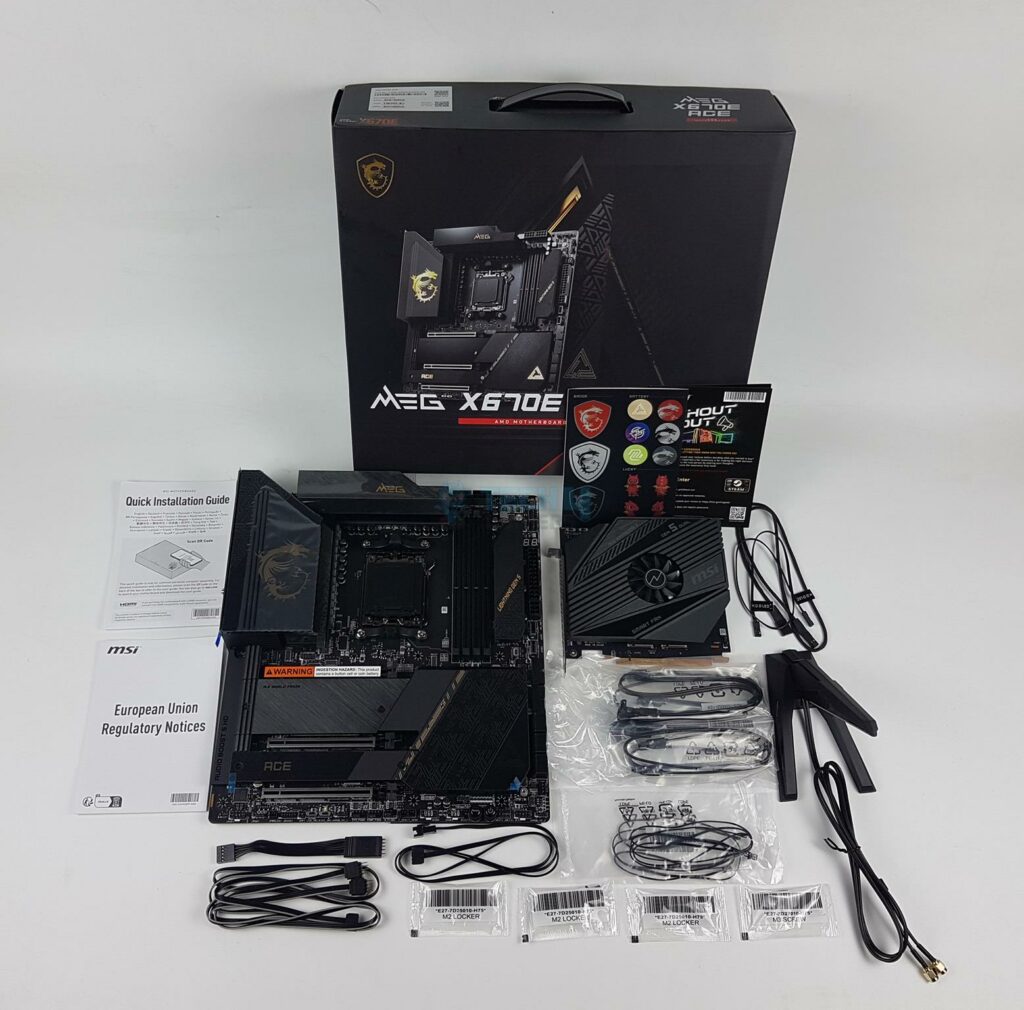
The motherboard is shipped inside a standard cardboard packing box. The box has a handle to easily carry the motherboard. The box is black finish. MSI has included the following in the box:
- 1x E-ATX Motherboard
- 1x M.2 XPANDER-Z Gen5 Dual
- 1x Wi-Fi Antenna
- 1x USB Drive
- 2 Plate Screws and EZ M.2 Clips
- 4x SATA 6Gbps Cables
- 1x Quick Installation Guide
- 1x European Union Regulatory Notice
- 1x Cable Sticker
- 2x Thermistor Cables
- 1x 1 to 2 RGB LED Extension Y Cable
- 1x Rainbow RGB LED Extension Cable
- 1x EZ Front Panel Cable
Design Overview
The MSI MEG X670E ACE uses an AMD AM5 socket that supports AMD Ryzen 8000 and 7000 CPUs. Since different SKUs have different levels of support for PCIe, refer to the user manual for more details. It has 4x DIMM slots. The motherboard has 8 PCB layers using IT-170 Server-grade PCB material and 2oz Thickened Copper. The on-board display coming from the socket includes only a Type-C Display Port capable of 4K@60Hz. In addition, this socket provides 20x PCIe lanes.
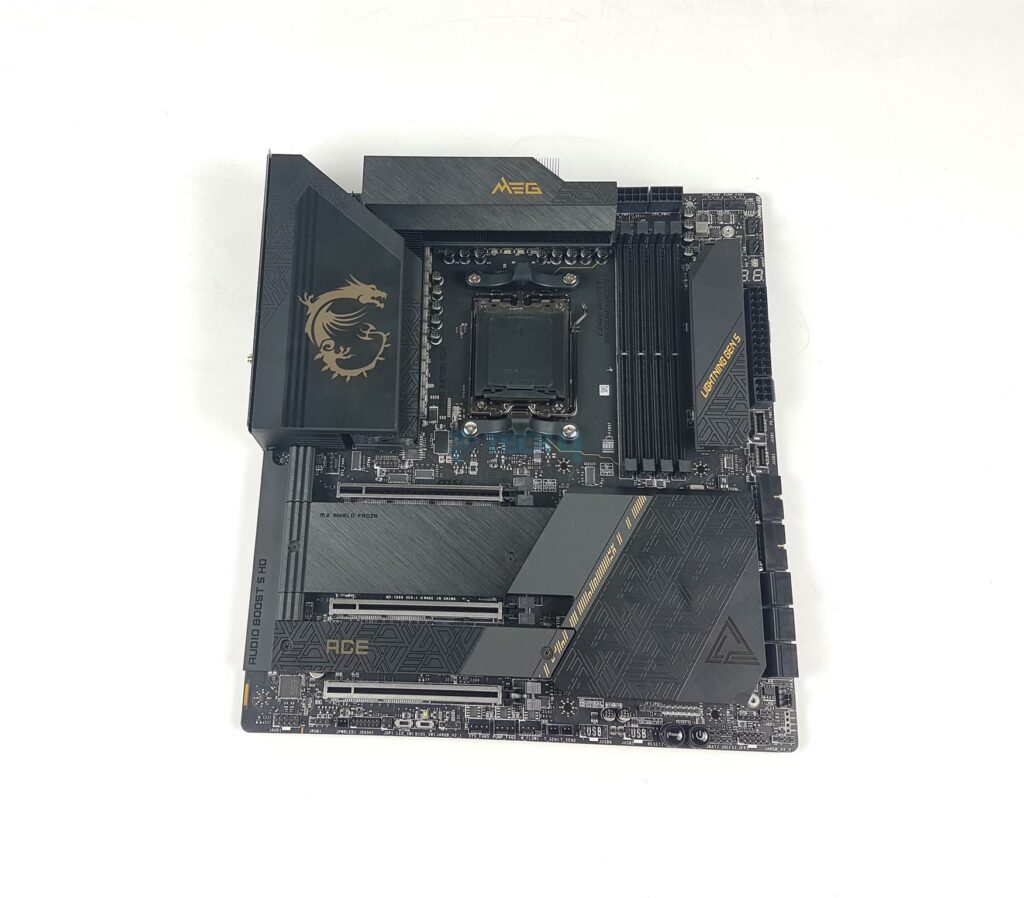
Out of a total of 4x M.2 ports, the M.2 Gen 5 is wired to the CPU whereas the rest are wired to the chiplets. This makes sense since all three PCIe slots are Gen5. The bulk of USB connectivity comes from the Chipset or Chiplets. MSI has included an XPANDER-Z Gen5 Dual module that allows the user to install 2x M.2 Gen5 SSDs. This seems to be the first generation since there is no plug-and-play support. Let’s start with the power delivery circuit of this motherboard.
Power Delivery To Socket
MSI is using AMD AM5 platform (LGA 1718). This socket supports the AMD Ryzen 7000 series CPUs out of the box. However, you need to update the BIOS for Ryzen 8000 series CPUs.
MSI has used two extended VRM heatsink covers (Stacked Fin Array Design) along with a heat pipe ensuring a maximum cooling provision for the power stages. The thermal pads are rated for 7W/mK to ensure effective heat transfer.
There is a Gold embellishment on the heatsink cover adding a subtle touch to the overall black theme of the motherboard. This is backlit and can be controlled using MSI Mystic Sync.
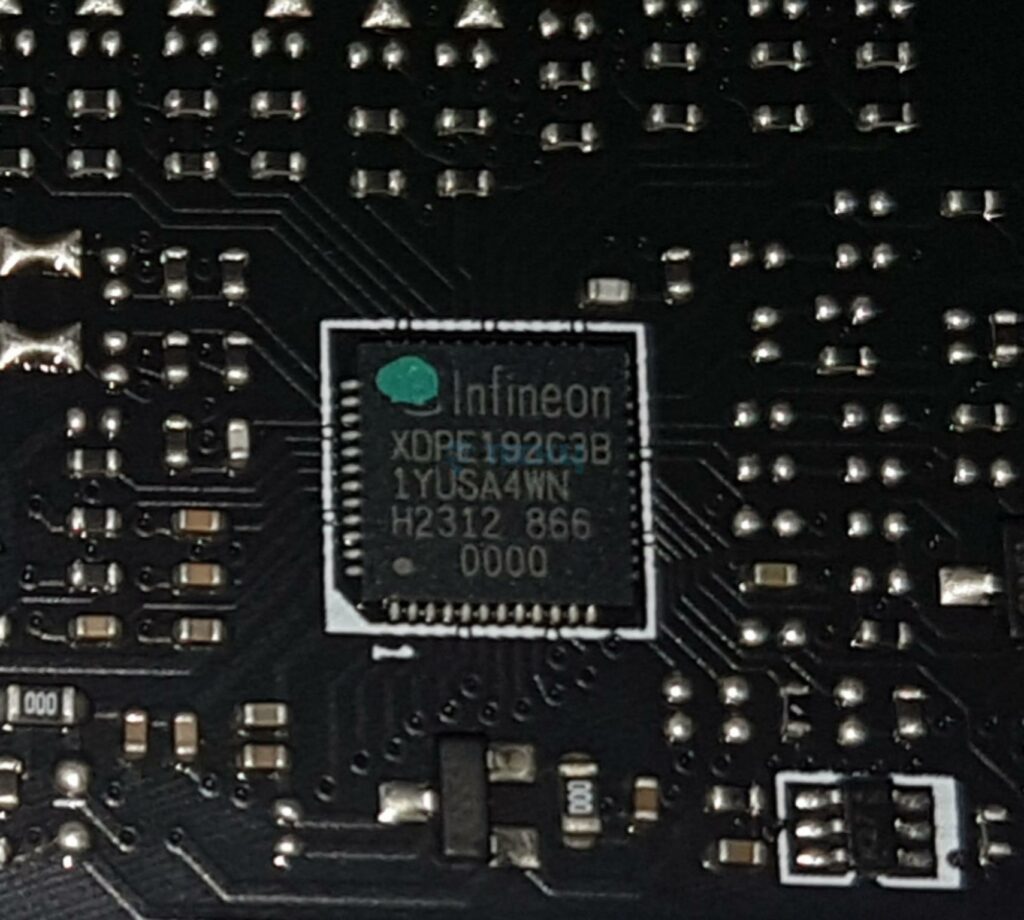
The MSI MEG X670E ACE features a powerful delivery circuit using a 22+2+1 phase VRM configuration. MSI has named it DUET meaning that every two stages will get the same PWM signal from the controller. The main driving force is the Infineon XDPE192C3B PWM controller.
The 22 VCore phases are from TDA21490. These power stages each support a maximum of 90 A of continuous current. For the SoC phase, MSI is using two Infineon TDA21472 70A power stages.
There is a backplate for the VRM/Phases on the backside of the motherboard.
DIMM Slots
MSI has used 4x DDR5 UDIMM slots. MSI has used the SMT welding process to install slots on the PCB for better performance. A total of 192GB capacity is supported along with a support for binary as well as non-binary memory kits. The maximum supported DDR5 frequency is 8000+(OC) MHz.
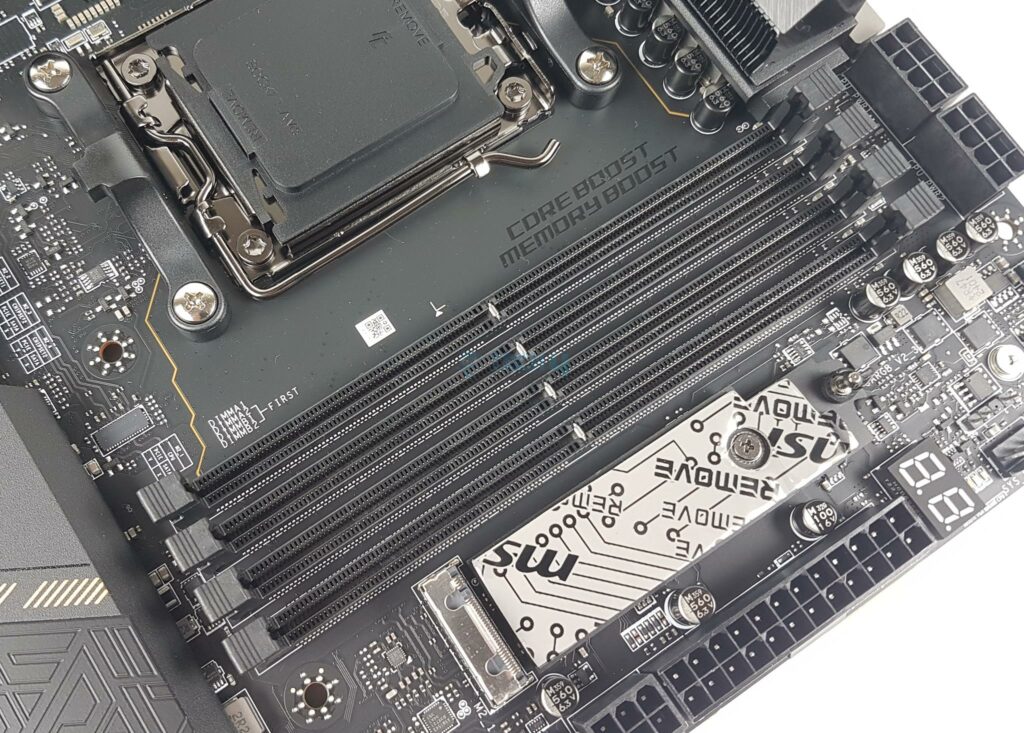
This motherboard supports AMD EXPO as well as Intel XMP with dual-channel and dual-controller modes. The supported memory is non-ECC and unbuffered. In addition, MSI has provided a handy Memory Boost and Memory Extension support in UEFI BIOS that enables the users to leverage the true performance of their DDR5 kits.
Storage Options
This motherboard has 4x M.2 slots and 6x SATA ports. Each M.2 slot or port has an aluminum cover for heat transfer which is finished in black color. The M.2 Shield Frozr tool-less cover is provided over the M.2 Gen5 port.
The overall footprint of this motherboard is quite appealing and eye-catching. Each slot has two thermal pads. One is on the base plate and the other is under the cover. The first and second ports are under a single cover whereas the last two M.2 ports have a single large-size aluminum cover.
I have removed the heatsink covers and shown the M.2 ports. You can see the thermal pads over the base of each slot.
The Gen5 port is located towards the DIMM slot area taking full advantage of the EATX form factor of the PCB. This port also has a thermal pad on the base. The dual thermal pad design makes these drives run cool and faster.
The M.2 Gen4 is wired to the CPU socket. The remaining ports are wired to the chipset. Also, it is interesting to see that only the M2_4 (PCIe 4) slot has 22110 support. The Gen5 does not support this form factor. All these ports conform to Key M.
All M.2 heatsink covers have thermal pads. Speaking of SATA ports, this motherboard has a total of 6x ports. SATA A1 and A2 ports are wired to the ASM1061 controller whereas the rest are wired to the Chipset.
PCIe Connectivity
This motherboard has a total of 3x Gen5 PCIe slots. For Ryzen 7000 series CPUs the configuration of these slots will be x16/0/x4 or x8/x8/x4. This configuration is x8/0/x4 for Ryzen 7 8700G and Ryzen 5 8600G. The Ryzen 5 8500G supports x4/0/x2.
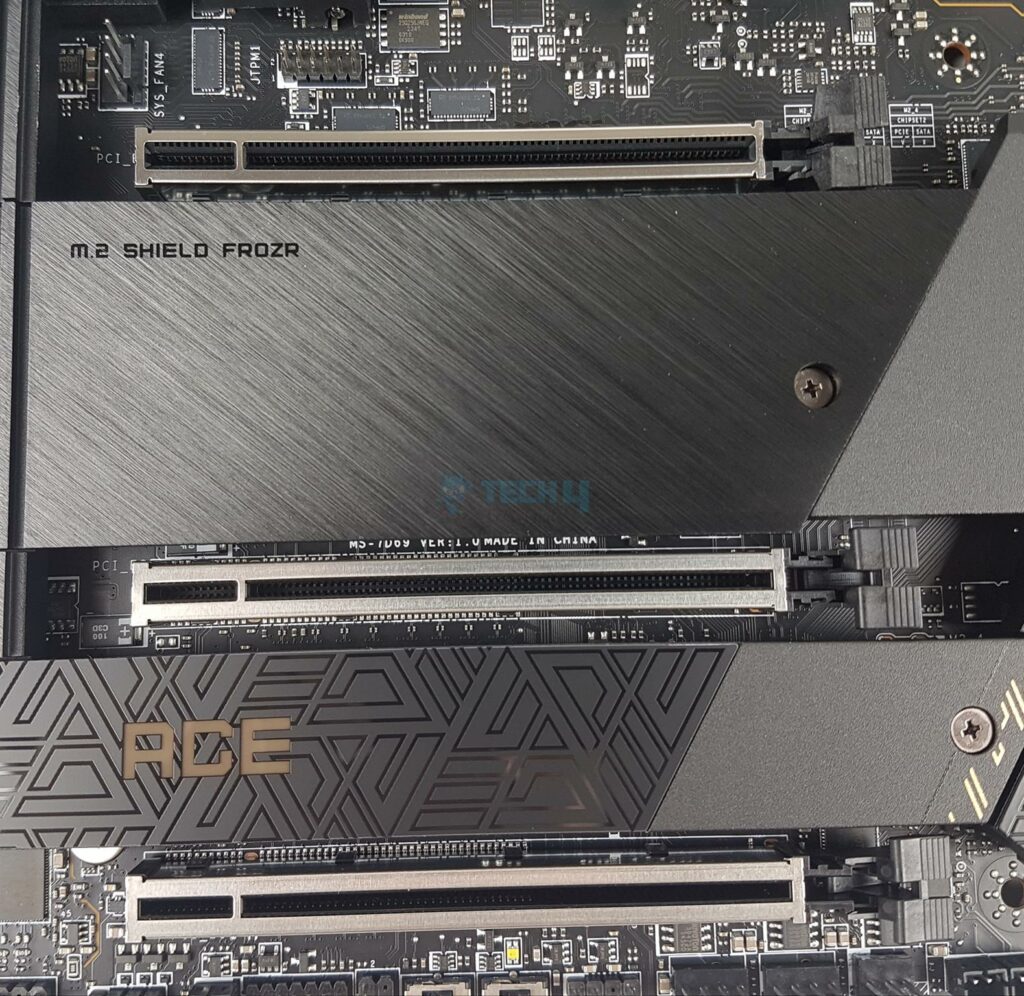
All three slots are wired to the CPU socket. Please note that the PCI_E3 supports up to PCIe 5.0 x4 and it shares a bus with 1x USB 3.2 Gen 2×2 port on the rear panel. Installing a device in PCI_E3 (XPANDER-Z for example) will disable the USB port. You can change the behavior in BIOS.
The top PCIe slot is steel reinforced which MSI refers to as Steel Armor and it has heavy soldered connections on the PCB to support the weight of a heavy graphics card. MSI has used the advanced SMT technology for the PCIE slot to diminish interference and electrical noise.
USB Connectivity
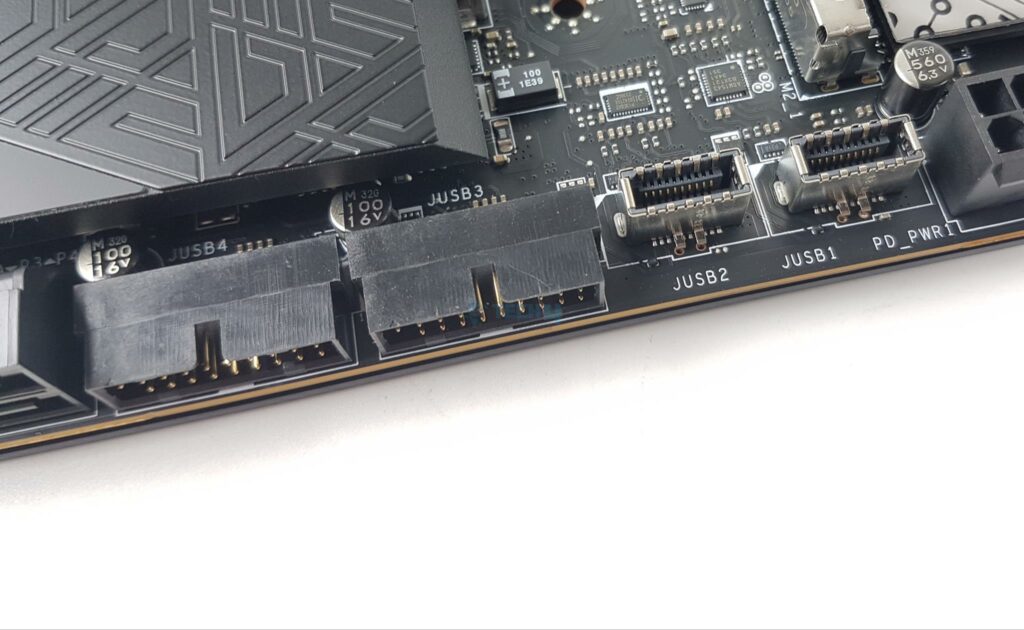
This motherboard is packed with USB ports on the front, rear, and mid-board. It has:
- 4x USB 2.0 (Front)
- 4x USB 2.0 ports (Front)
- 4x USB 5Gbps Type A (Front)
- 8x USB 10Gbps Type A (Rear)
- 1x USB 10Gbps Type C (Rear)
- 1x USB 10Gbps Type C (Front)
- 2x USB 20Gbps Type C (Rear)
- 1x USB 20Gbps Type C (Front)
Thanks to the Chiplet design on the Chipset side, we have more lanes hence more USB connections on the AMD platform. I appreciate the provision of 3 USB 3.2 Gen2x2 ports. One port is dedicated to 60W PD for which you would need to connect a 6-pin PEG connector. This is done via the ITE IT8856FN controller. MSI has used several USB hubs and controllers including ASM1543, ASM1074, P13DPX, PI3EQX10, and PI3EQX2.
Networking Solution
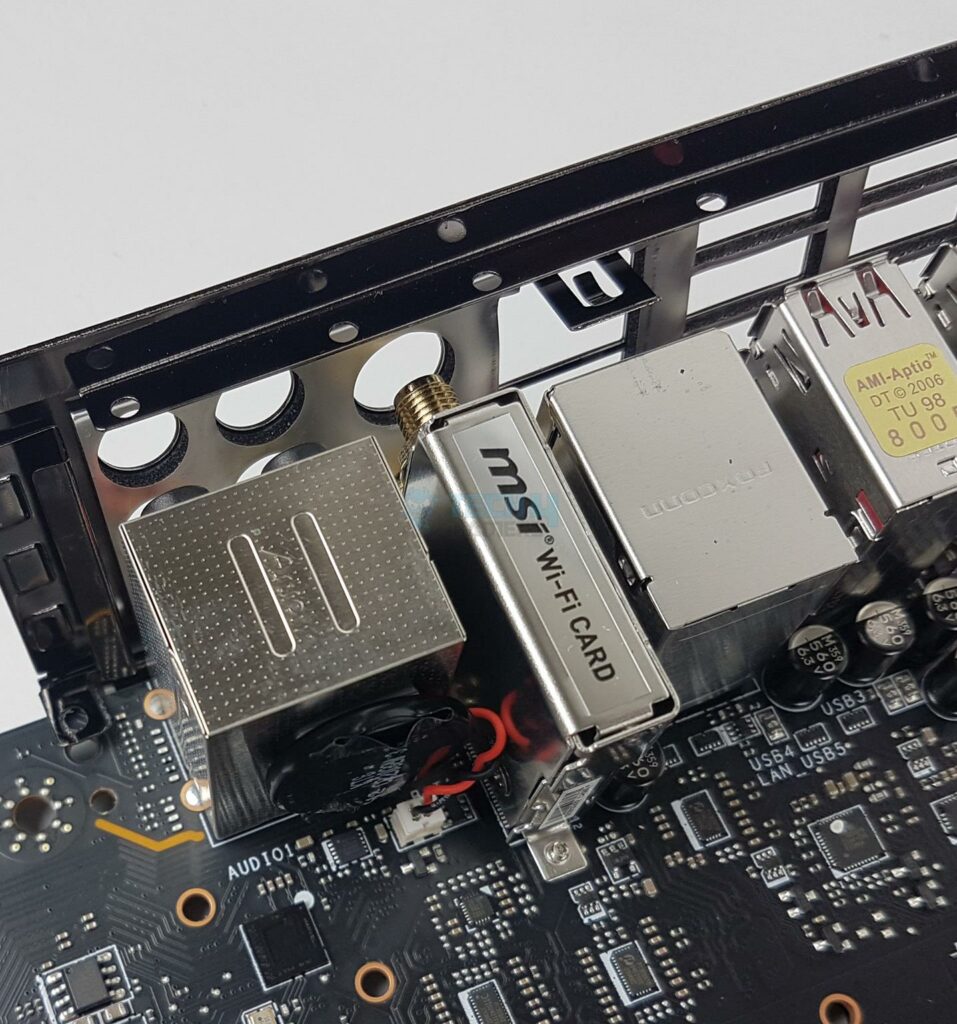
This motherboard packs a powerful 10G LAN port on the rear panel driven by a Marvell AQC113CS-B1-C LAN controller. The wireless connectivity comprises WiFi 6E and Bluetooth 5.2. The module is installed in the M.2 Key-E slot on the rear panel.
The antenna is magnetic making its placement convenient. The WiFi 6E supports MU-MIMO TX/RX and 20MHz, 40MHz, 80MHz, and 160MHz bandwidth in 2.4GHz/5GHz. It supports 802.11 a/b/n/g/ac/ax.
Audio Solution
MSI has implemented Audio hardware on two separate layers of the PCB. They have used RealTek ALC4082 codec in combination with high-performance Chemi-Con capacitors. It is the same codec that I saw on Z790 Tomahawk Max WiFi but MSI has used more capacitors in the ACE motherboard.
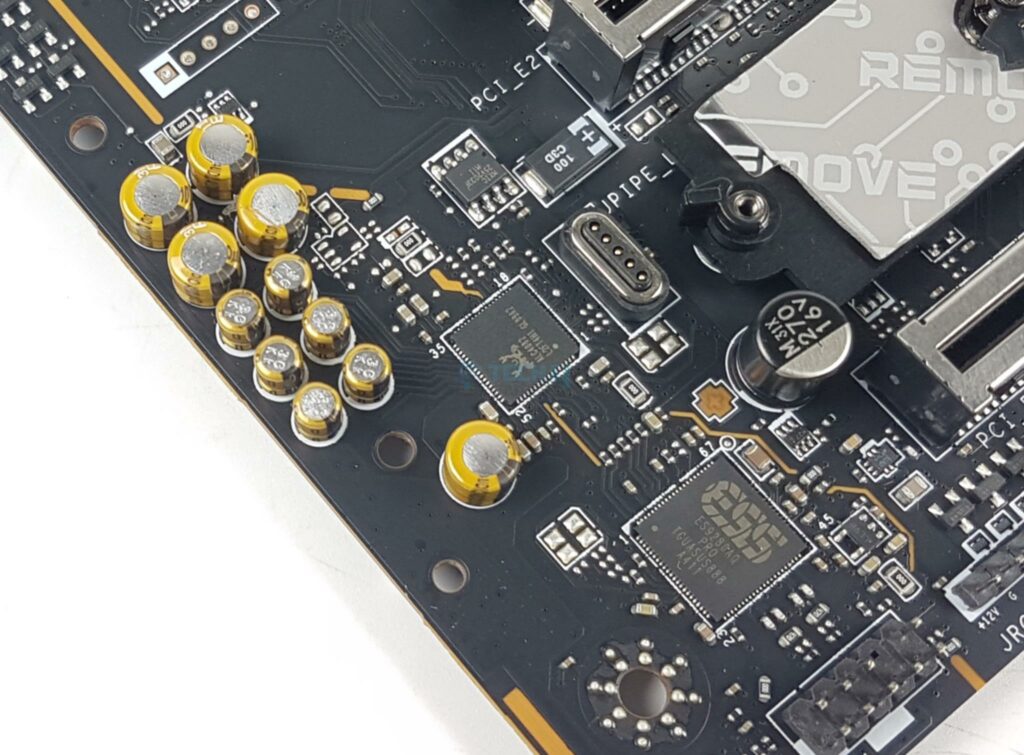
There is also ESS ES9280AQ Combo DAC and HPA. This is a 1x 7.1 Channel audio solution that has S/PDIF output as well. It supports up to 32-bit/384 kHz playback on the front panel. MSI has designed the isolated analogy structure for the output on the rear panel. In this design, the external metal housing is separated from the internal layout to further improve the sound quality. The audio solution is the same as I saw in the MEG Z790 ACE MAX.
Chipset
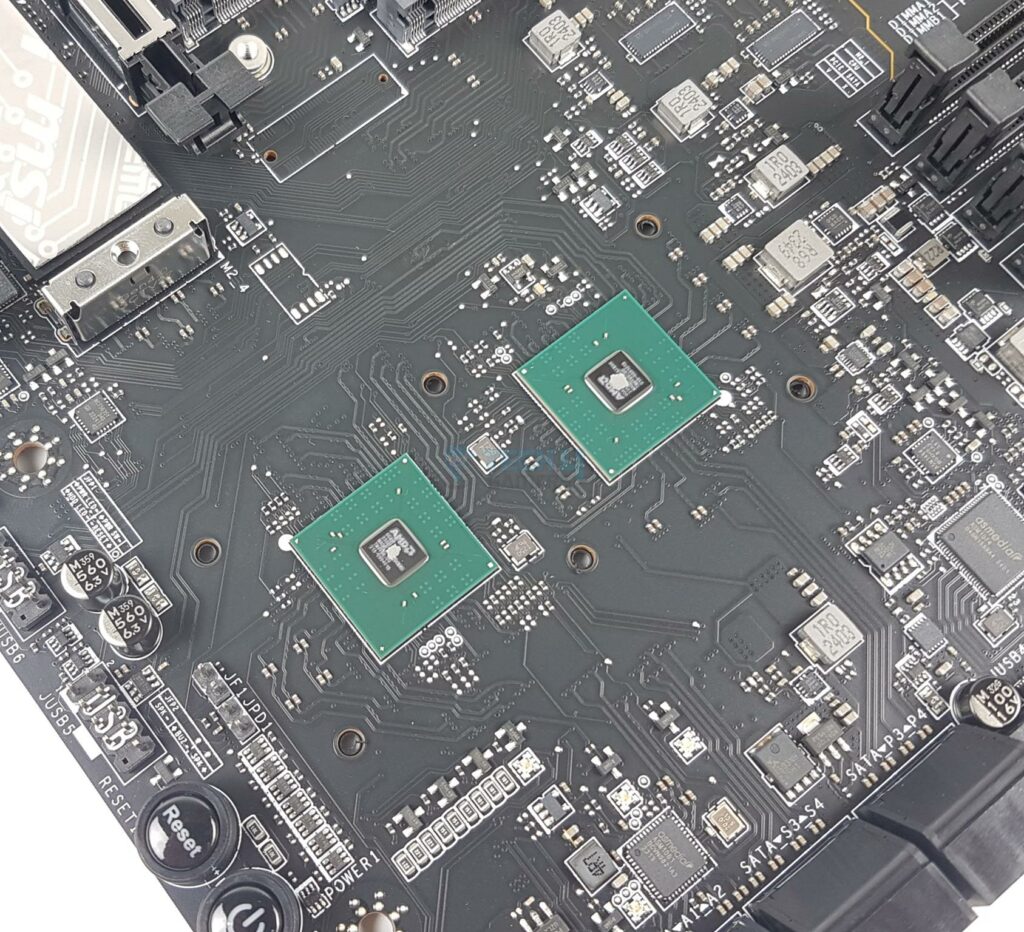
I am showing X670E chiplets after removing its heatsink cover.
Internal Connectors
There are:
- 1x 24-pin Power Connector (ATX_PWR)
- 2x 8-pin EPS Power Connectors (CPU_PWR)
- 1x Front Type-C Quick Charge Connector (PD_PWR1)
- 1x CPU Fan Header
- 2x Pump Fan Header
- 5x System Fan Headers
- 2x Front Panel (JFP) Connectors
- 1x Chassis Intrusion (JCI)
- 1x Water Flow connector
- 1x Slow Mode Booting Jumper (JSLOW)
- 1x Front Audio (JAUD) Connector
- 2x Thermal Sensor connectors (T_SEN)
- 1x Tuning Controller connector (JDASH)
- 3x Addressable V2 RGB LED connectors (JARGB_V2)
- 1x RGB LED connector (JRGB)
- 1x TPM pin header (Support TPM 2.0)
- V-check points
- 4x USB 2.0 ports
- 4x USB 5Gbps Type A ports
- 1x USB 10Gbps Type C ports
- 1x USB 20Gbps Type C ports
Each fan header is powered and controlled by nuvoTon 3961S. The same controller was used in MEG Z790 ACE MAX. The Pump and CPU Fan headers are rated for 3A whereas the system fan headers are rated for 2A each.
In addition to Debug LEDs, there are EZ Debug LEDs to troubleshoot the system in case anything goes haywire. These LEDs correspond to the CPU, RAM, VGA, and Boot. I appreciate 2x external sensor ports. The power connectors use solid pins that improve stability by providing low impedance and durability with high current-withstanding capability.
MSI has also provided V-Check read points for VCore and SoC. You would need a voltmeter to read the values.
Rear IO Panel
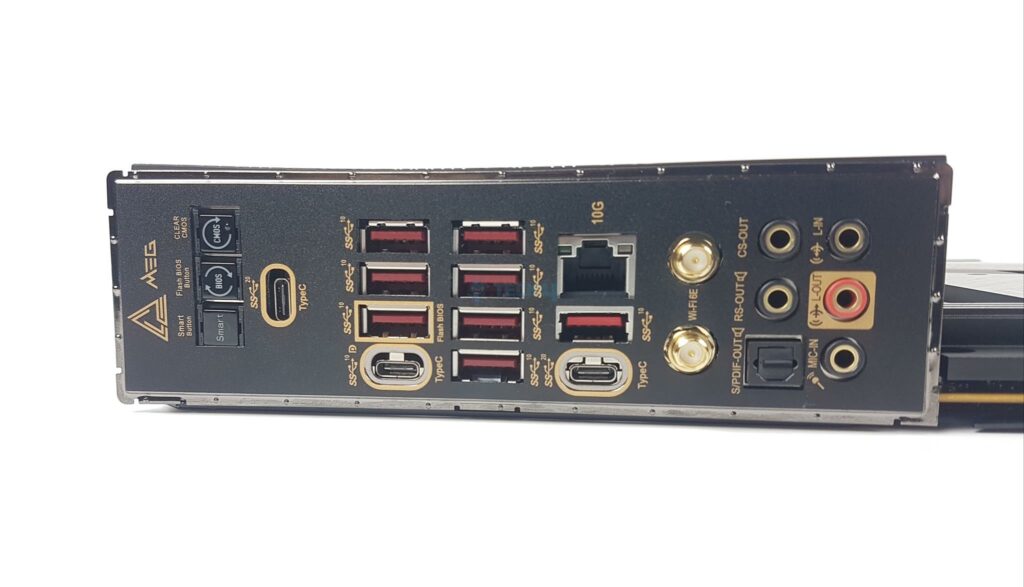
There are:
- Clear CMOS Button
- Flash BIOS Button
- USB 3.2 Gen 2 10Gbps (Type-A)
- 10G Super LAN
- Wi-Fi / Bluetooth
- HD Audio Connectors
- Smart Button
- USB 3.2 Gen 2×2 20Gbps (Type-C)
- USB 3.2 Gen 2 10Gbps (Type-C Display port)
- USB 3.2 Gen 2×2 20Gbps (Type-C)
- Optical S/PDIF-Out
There is a backplate on the backside that prevents the motherboard from bending and provides an additional cooling surface. I am showing the backside of the motherboard where MSI has provided Transient Voltage Suppressors. These are safety devices that are used to protect against the excessive voltage. In case of abnormal voltage hikes, the TVS switches from a high-resistance state to a low-resistance state hence grounding the excessive voltage.
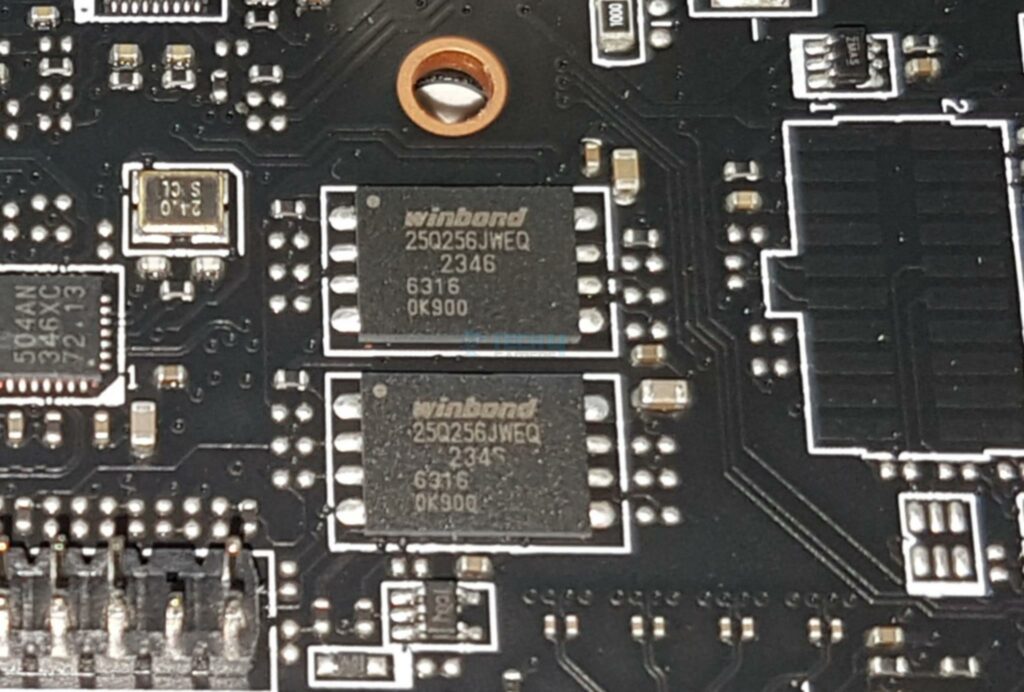
MSI uses two winband 25Q256JWEQ 256M-bit Serial Flash Memory with uniform 4KB sectors and Dual/Quad SPI. In simple words, these are your BIOS chips.
XPANDER-Z Gen5 DUAL
MSI has bundled an M.2 XPANDER-Z Gen5 DUAL PCIe card with the motherboard. This card has a single fan to keep the SSDs cool during operations. There is a stylish black heatsink cover over the top. This is not a tool-less design as the user is required to open the card and install the SSDs.
There are 4x screws on the backside of the card. Remove these to open the heatsink cover.
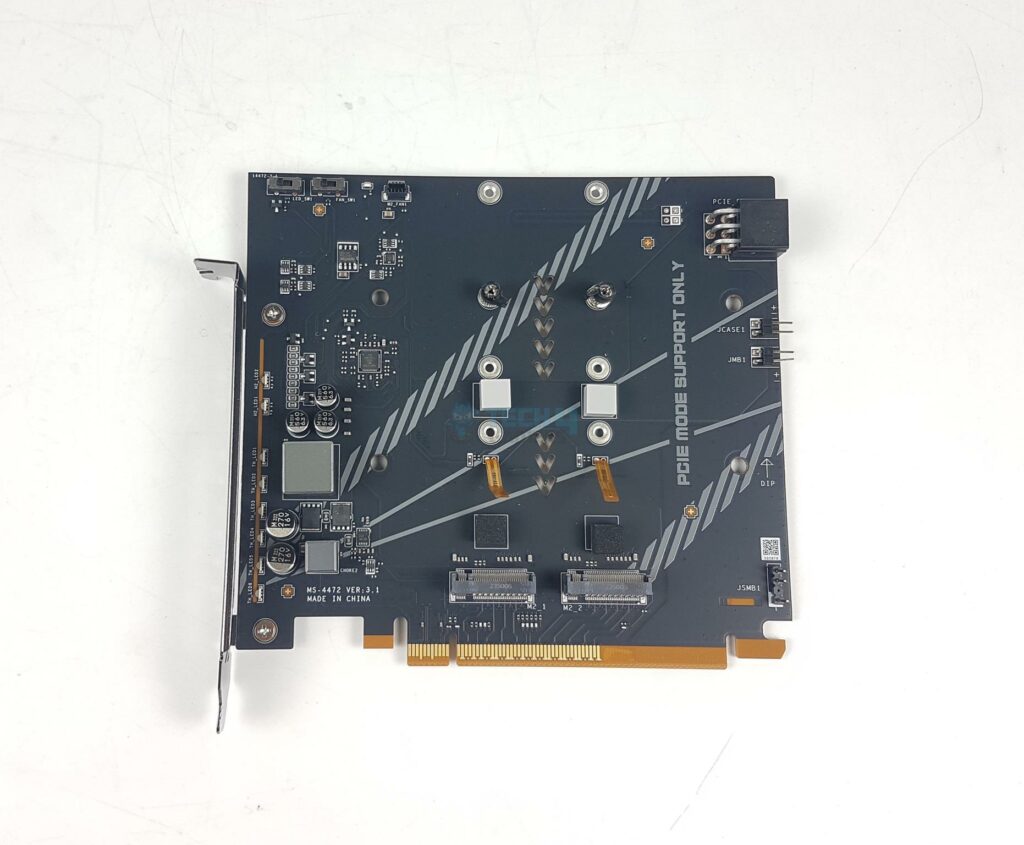
I am showing the PCB of the card. There are two Key M type M.2 ports conforming to PCIe Gen5. MSI has provided a plethora of connectors on the PCB making this card compatible with the MSI motherboards. However, the good news is that these are optional except for the 6-pin PCIe connector which is a must. There are:
- JCASE1 header to which you can connect the HDD LED Connector
- JMB1 and JSMB1 allow the user to control the fan’s speed, thermal sensors, SSDs’ stats, and LEDs.
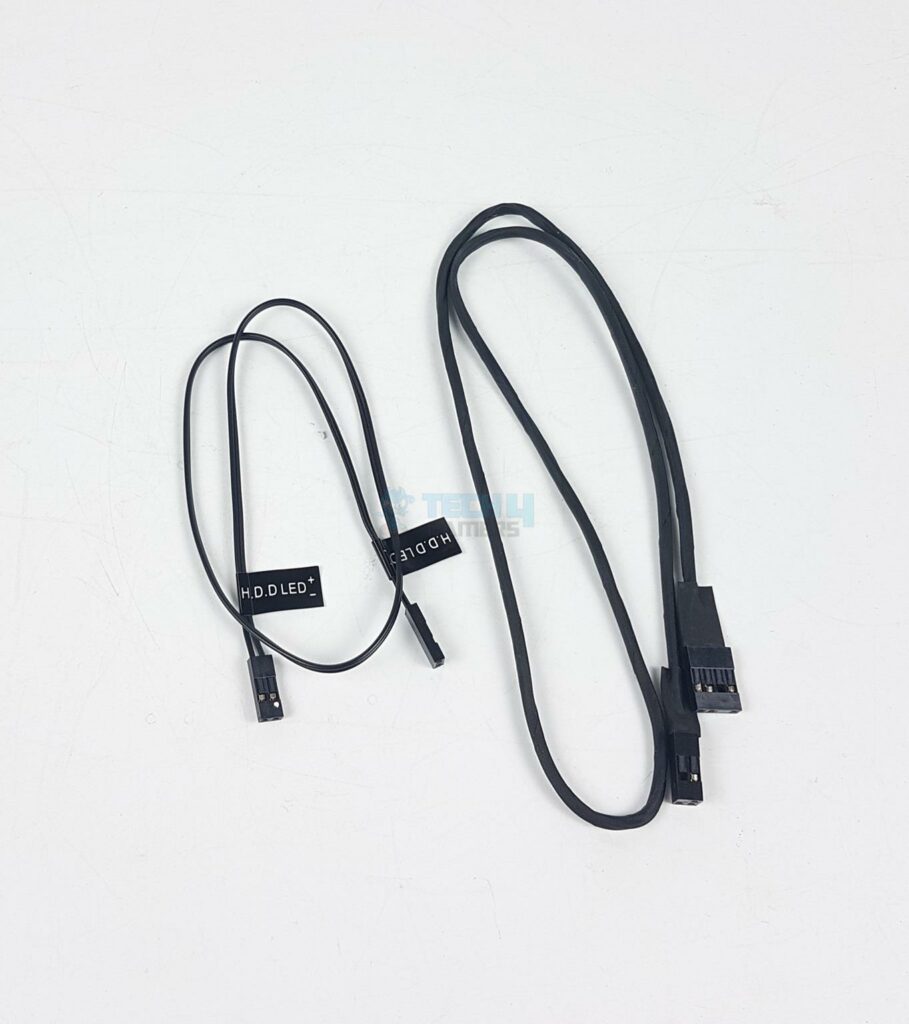
MSI has provided two connector cables for connectivity between this card and the motherboard.
You can control the on-board LEDs using the slider button in addition to the fan control slider button. MSI has used nuvoTon 3974S controller. There is a port for SMART fan control. I detached the cable while removing the heatsink.
There are two thermal pads under the heatsink cover.
BIOS
The BIOS interface is similar to what I saw on the other MSI motherboards that I have tested so far. BIOS starts in the EZ mode. Press F7 to switch to Advanced mode. EXPO/XMP is just one click thanks to user user-friendly interface. CPU, RAM, and Voltage settings are grouped under the OC menu. System-related configuration options are grouped in the Settings menu. Boot and Exit options are also under the Settings menu.
You can control the speed of the fans on the Hardware monitor page. OC Profiles allow the users to save their configurations in the files and restore from the saved files. This would come in handy during installation. M-Flash is used to update the BIOS ROM. Power limits are available in Advanced CPU Configuration.
PBO is your ally when it comes to tweaking and tuning. Performance Switch can be used to access the MSI’s own OC settings. You can also access the thermal point profiles pre-defined in the PBO settings as well as the ECO mode and different TDP settings (PPT/TDC/EDC).
For the software part, you can check it in our Z790 Tomahawk Max WiFi motherboard review.
Test Build
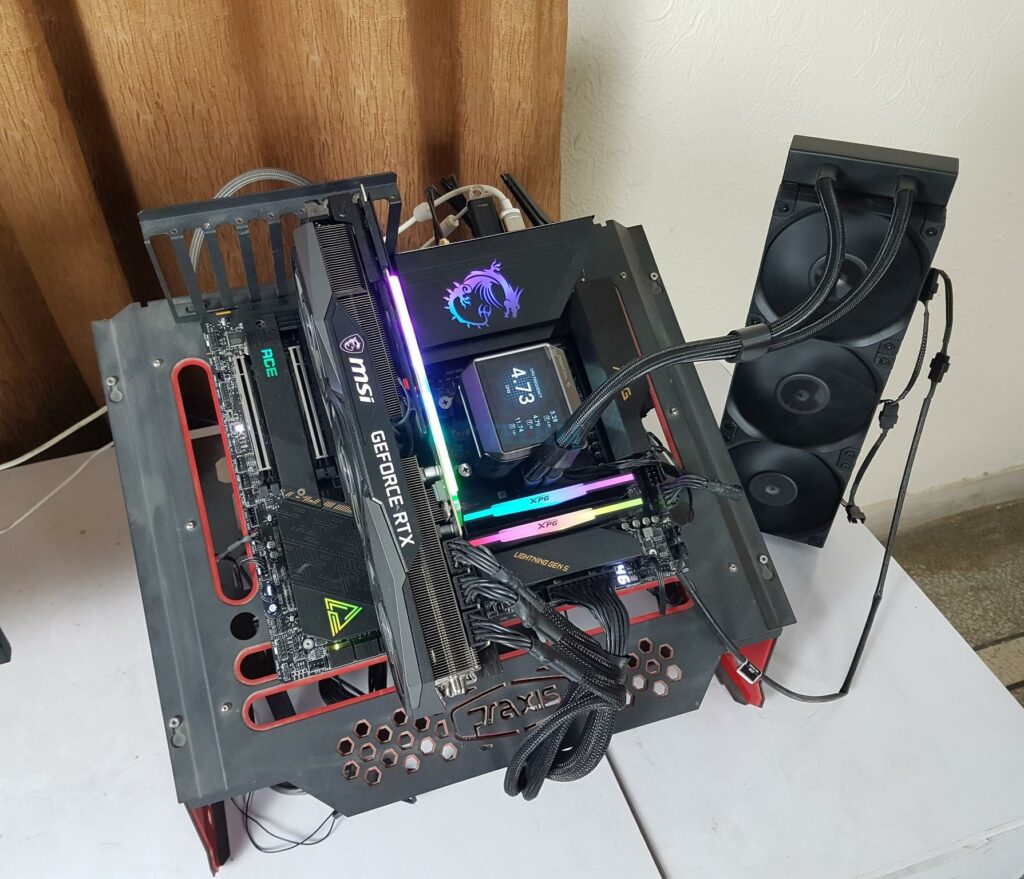
I have used the following configuration to test the motherboard:
- MSI MEG X670E ACE
- MSI GeForce RTX 3090 Gaming X Trio 24G
- AMD Ryzen 7 7800X3D [Stock, Auto]
- DeepCool Mystique 360
- XPG Lancer RGB 32GB 6000MHz DDR5 kit
- Western Digital SN850 Black 500GB NVMe SSD [For OS]
- Sabrent Rocket 4 Plus 2TB Gen4x4 NVMe SSD [For Software]
- Sabrent Rocket 4 Plus 4TB Gen4x4 NVMe SSD [For Games]
- Sabrent Rocket NANO V2 4TB Portable SSD
- Fractal Design ION+ 2P 860W Platinum
- Praxis Wetbench
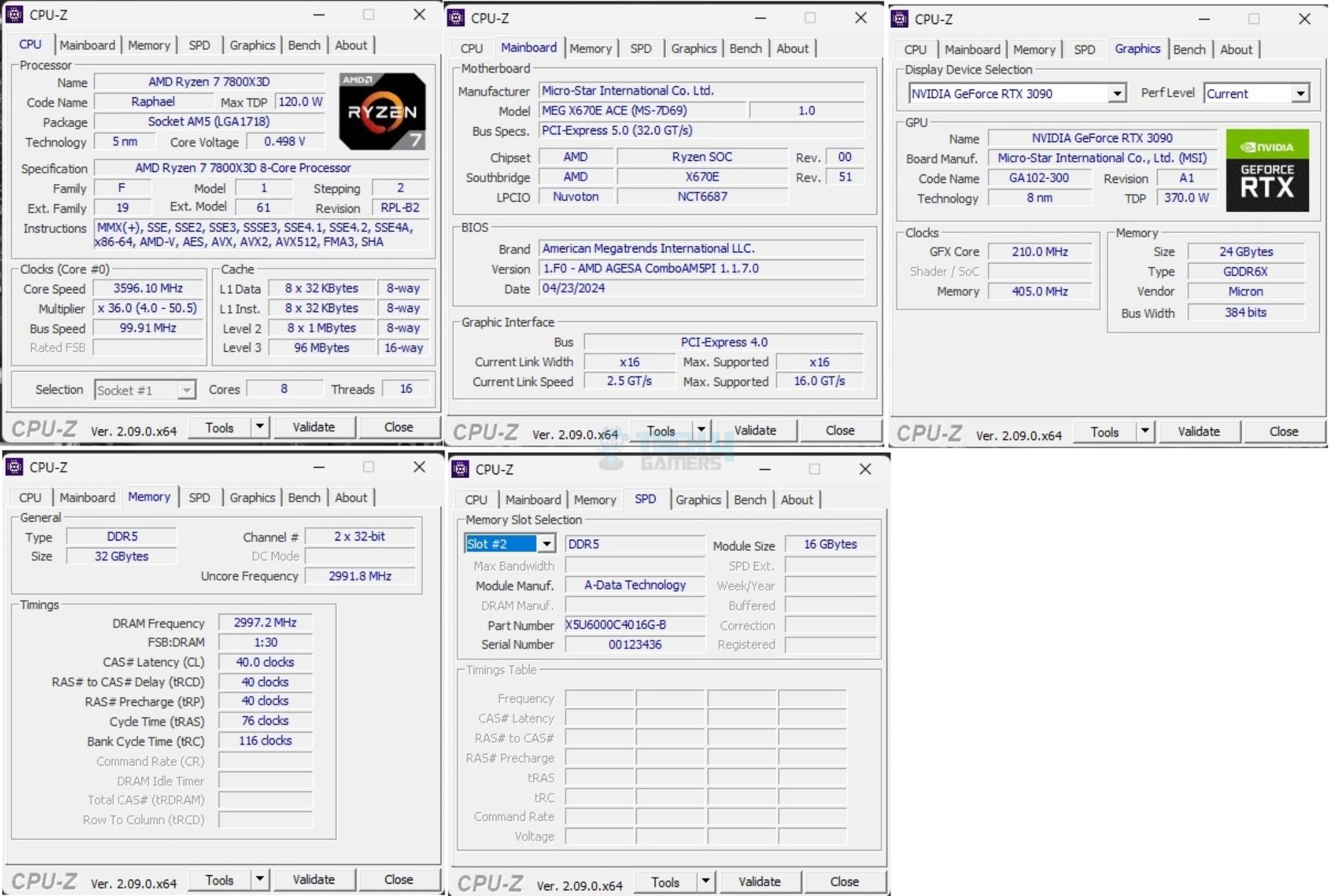
The above is a picture showing a run of CPU-Z. We can see that the CPU is reported at 3.9GHz at 120W. You can also see that the graphics card is operating at the x16 link. The RAM is operating at its tested speed of 7200MT/s after loading the XMP. However, SPD timings could not be read on each module by the software.
We have divided the overall tests in four major categories. These are:
- CPU and Memory Tests
- Storage Tests
- Gaming Tests
- Overall System Tests
Test Result
The testing was done on stock settings with XMP loaded. This motherboard has powers unlocked by default.
CPU And Memory Benchmarks
In Cinebench R23.2 the CPU scored 17589 points in CPU Multi Core load and 1775 points in a Single Core Load. The DDR5 kit has performed well at its tested speed of 6000MHz. The single core score of 1979 from Gekbench 5.4.5 is quite well. The performance in the 7-Zip benchmark is satisfactory as well with a compression result of 89279MIPS and 82657MIPS score in Decompression. The blender benchmark overall score was 273.71.
Storage Test
I have used:
- Gen4x4 NVMe Drive
- USB 3.2 Gen2x2 Type-C Drive [Rated for 1600MB/s]
Both drives passed their sequential speeds in the CrystalDiskMark. The performance in PCMARK10 Data Drive Benchmark is quite well. The Gen4x4 NVMe drive scored 3486 and the USB drive scored 633 score. These scores are low compared to Intel which is a platform limitation.
Gaming Test
We have a good all-round performance in the gaming benchmarks. This shows that this motherboard can handle the gaming load easily.
System Performance Test
The PCMARK10 score came to 9089 which is good and the Performance Test overall score was 10022.
Core Clock Behavior
I have a Balanced Power profile in Windows Environment. To record the idle temperatures, the system was put on idle for 10 minutes. The idle clocks were 3156MHz. The cores boosted to 5.06GHz under 1T load using R23.2 whereas these cores boosted to 4.93GHz under all cores load. These figures confirm AMD’s clock ratings for Ryzen 7 7800X3D.
Thermals And Power
The CPU Package power draw was 86.990W on all cores load using Cinebench R23.2. The Graphics card under full stress test load was doing 376W.
Testing was done at an ambient temperature of 30ᵒC. the CPU was idling at 43.5ᵒC and the graphics card was idling at 35ᵒC. Under load, the CPU was doing 81ᵒC whereas the GPU was doing 83ᵒC.
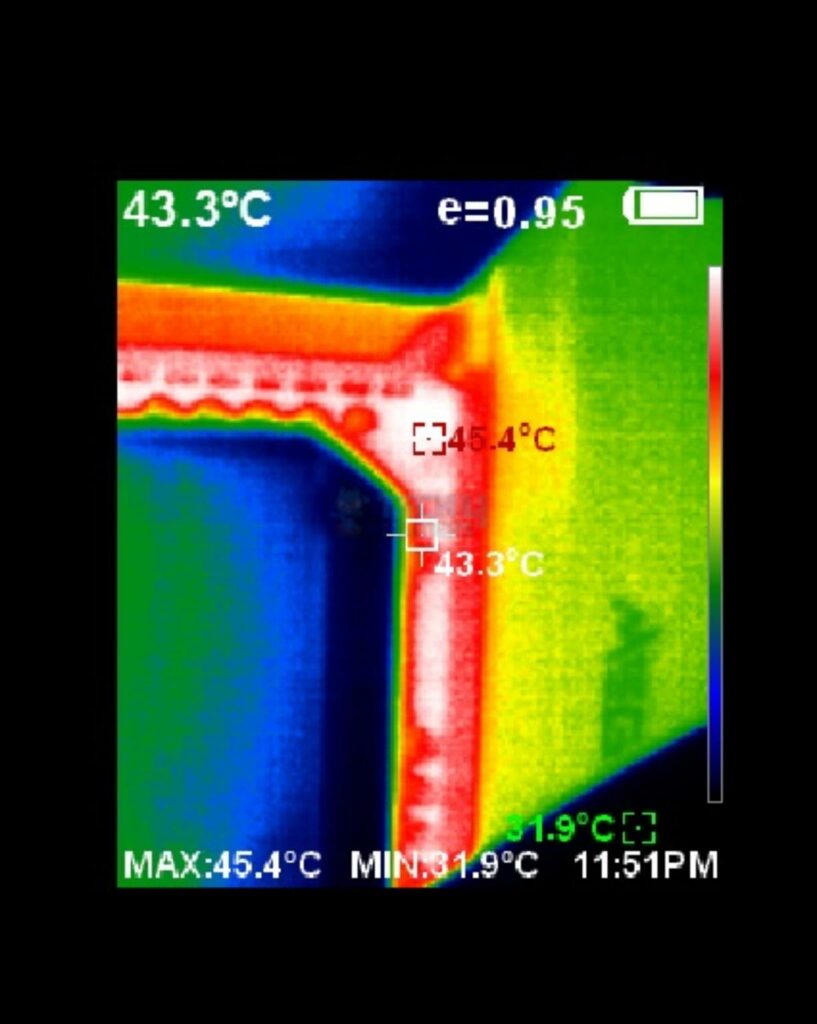
The VRM/MOSFET was doing 45.4ᵒC at an ambient of 28ᵒC.
I have praised MSI MEG Z790 ACE MAX as the best VRM/MOSFET cooling solution. The MEG X670E ACE also did not disappoint.
Should You Buy It?
Buy It If
✅You are looking for a flagship motherboard: MSI MEG X670E ACE is a top-tier motherboard that boasts a well-balanced feature set that suits gamers, content creators, and professionals alike.
✅Gen5 Connectivity is your requirement: MSI MEG X670E ACE has 3x Gen5 PCIe slots and 1x Gen5 M.2 ports onboard with two additional ports coming from bundled PCIe Cards. This is a heaven.
✅You need high-speed USB Connectivity: MSI MEG X670E ACE has a total of three USB 3.2 Gen2x2 Type-C ports which is too good.
✅You want best-in-class cooling for power stages: MSI has used stacked fin array heatsinks that are interconnected using copper heat pipes. The thermal pads are quite thick which seems to be over 2mm in thickness and are rated for 7W/mK. This provides the best cooling solution as I have seen in my testing.
Don’t Buy It If
❌You are a budget user: Coming in at USD 679.99, this motherboard is not for every user and not even the mainstream users. Take a look at X670E Carbon WiFi instead.
My Thoughts
MSI MEG X670E ACE flagship motherboard from MSI on the AMD platform. This board has 22+2+1 power phases (DUETS) with enlarged heat sinks (array Fins) that are using a heat pipe and there are 7W/mK rated thermal pads under these covers. MSI has integrated sensors to report temperature and power values from two different rails. There is over-current and over-voltage protection as well. The BIOS interface is the same as we have seen on the MSI motherboard.
Speaking of Gen5 connectivity, this motherboard is heaven. It has a total of 3 PCIe Gen 5 steel reinforced slots wired to the CPU socket. Their behavior/configuration is dependent on the installed CPU. There is a single M.2 Gen5 port on-board wired to the CPU socket. the PCIe slots are SMT welded.
MSI has provided a first-generation M.2 XPANDER Gen5 DUAL PCIe card that provides two additional Gen5 M.2 ports. The third PCIe slot shares bandwidth with one USB 3.2 Gen2x2 Type-C port on the rear panel. Installing a card in a third PCIe slot will disable the USB port. You can change the selected device from the BIOS.
Each M.2 heatsink has dual thermal pads. Gen5 port has a tool-less handling. However, this port does not support the 22110 form factor. This motherboard has a total of 6 SATA 6G ports. Two are controlled via ASM1061 and the rest are wired to the chipset.
The board has support for up to 192GB RAM Capacity with up to 8000+(OC) MHz frequency. Speaking of USB connectivity, this board has a strong game compared to the competition. Not only does this board have three USB 3.2 Gen2x2 20Gbps ports in addition to 18x other USB ports, this motherboard also provides a 60W PD function from the front Type E USB port.
This motherboard retails at USD 679.99 which is a steep price but the feature set makes up for this price. This motherboard has a solid performance particularly the VRM temperatures under load were impressive. This motherboard has a 3-year warranty from MSI.
Community Poll
Thank you! Please share your positive feedback. 🔋
How could we improve this post? Please Help us. 😔
[Reviews Specialist]
Usman Saleem brings 8+ years of comprehensive PC hardware expertise to the table. His journey in the tech world has involved in-depth tech analysis and insightful PC hardware reviews, perfecting over 6+ years of dedicated work. Usman’s commitment to staying authentic and relevant in the field is underscored by many professional certifications, including a recent one in Google IT Support Specialization.
8+ years of specialized PC hardware coverage
6+ years of in-depth PC hardware analysis and reviews
Lead PC hardware expert across multiple tech journalism platforms
Certified in Google IT Support Specialization
Get In Touch: usman@tech4gamers.com


 Threads
Threads
